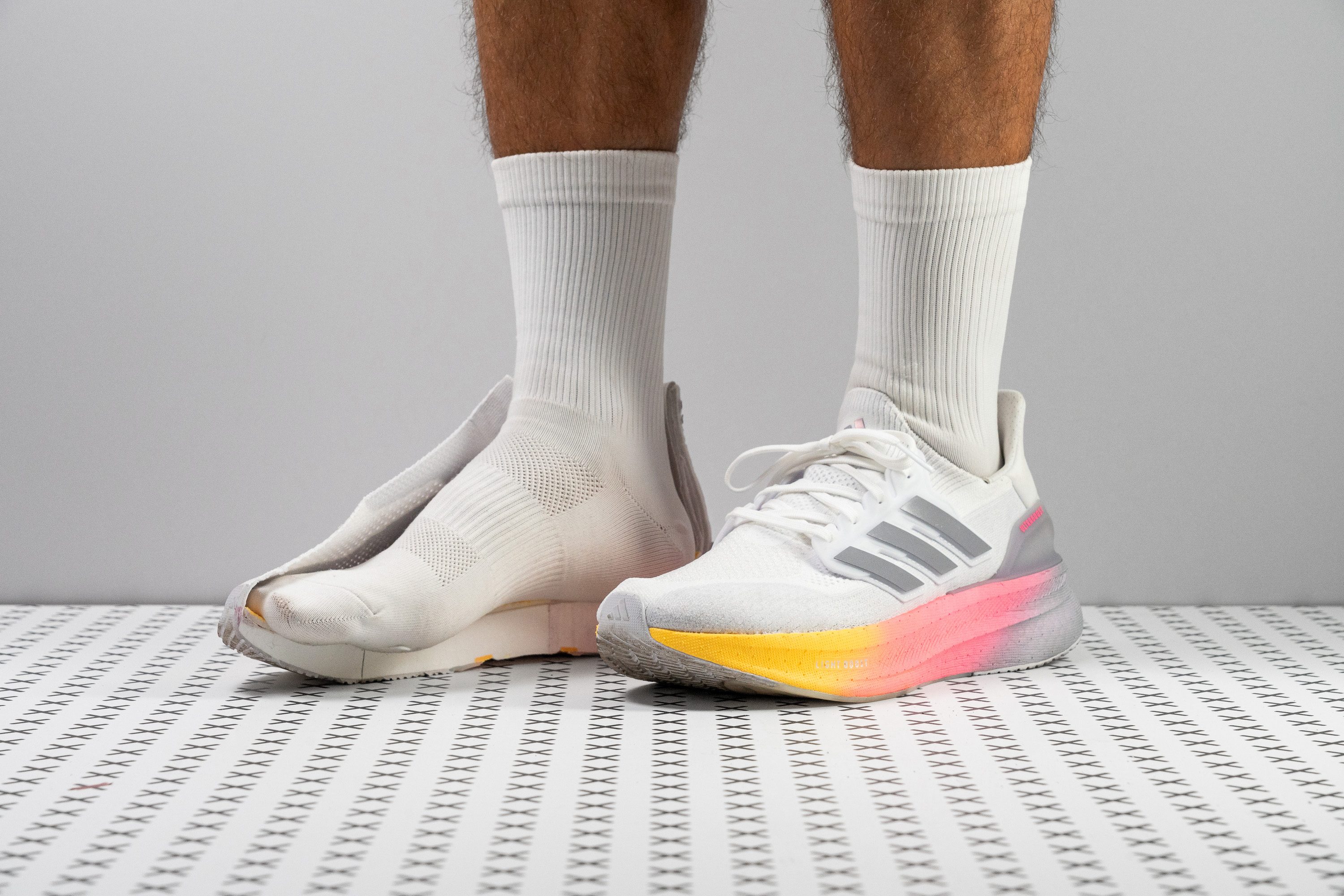Nuestra conclusión
Pros
- Mayor amortiguación en la mediasuela
- Parte superior de knit cómoda y espaciosa
- Adecuadas para el uso diario
- Resistencia excelente
- Ideales para los talonadores
- Suela exterior Continental de primera
- Más amortiguadas que nunca
- Aptas para los corredores de metatarsos
- Ideales para el verano
Contras
- Podrían ser todavía más lgieras
- No son aptas para ritmos rápidos
- Puede que haya deslizamiento del talón
Veredicto de los usuarios
- Top 16% entre Zapatillas de running para asfalto
- Top 15% entre zapatillas de running neutras
Comparativa
Las zapatillas de running más parecidas
+ + Añadir unas zapatillas | |||||
|---|---|---|---|---|---|
| Puntuación global | 90 Excelentes | 89 Notables | 89 Notables | 93 Excelentes | |
| Precio | 180 € | 140 € | 170 € | 150 € | |
| Pace | Correr a diario | Correr a diario | Correr a diario | Correr a diarioTempo / series | |
| Absorción de impactos | Moderada | Alta | Moderada | Alta | |
| Retorno de energía | Alto | Bajo | Alto | Alto | |
| Tracción | Alta | Moderada | Moderada | Moderada | |
| Arch support | Neutral | Neutral | Neutral | Neutral | |
| Peso laboratorio Peso marca | 10.3 oz / 292g 11.4 oz / 323g | 9.7 oz / 274g 9.5 oz / 270g | 9.9 oz / 281g 10 oz / 284g | 7.9 oz / 223g 7.9 oz / 224g | |
| Lightweight | ✗ | ✗ | ✗ | ✓ | |
| Drop laboratorio Drop marca | 10.6 mm 10.0 mm | 10.5 mm 5.0 mm | 8.9 mm 8.0 mm | 8.0 mm 6.5 mm | |
| Técnica de carrera | Talón | Talón | TalónMedio/antepié | TalónMedio/antepié | |
| Talla | Tallan bien | Tallan bien | Tallan bien | Tallan bien | |
| Rigidez de la mediasuela | Blanda | Blanda | Equilibrada | Equilibrada | |
| Diferencia de la rigidez de la mediasuela en frío | Pequeña | Normal | Pequeña | Pequeña | |
| Durabilidad de la parte delantera | Decente | Mala | Decente | Mala | |
| Durabilidad del acolchado del talón | Alta | Media | Baja | Alta | |
| Durabilidad de la suela exterior | Buena | Buena | Mala | Buena | |
| Transpirabilidad | Alta | Alta | Media | Alta | |
| Anchura / ajuste | Ancha | Media | Media | Media | |
| Anchura de la parte delantera | Ancha | Media | Media | Media | |
| Flexibilidad | Rígida | Moderada | Moderada | Flexible | |
| Rigidez torsional | Rígidas | Rígidas | Rígidas | Rígidas | |
| Rigidez del contrafuerte del talón | Moderado | Rígido | Rígido | Moderado | |
| Rocker | ✗ | ✗ | ✓ | ✓ | |
| Talón laboratorio Talón marca | 35.2 mm 39.0 mm | 40.7 mm 40.0 mm | 36.1 mm 37.0 mm | 36.1 mm 38.5 mm | |
| Antepié laboratorio Antepié marca | 24.6 mm 29.0 mm | 30.2 mm 35.0 mm | 27.2 mm 29.0 mm | 28.1 mm 32.0 mm | |
| Anchuras disponibles | Estándar | EstándarAncho | Estándar | EstándarAncho | |
| Orthotic friendly | ✓ | ✓ | ✓ | ✓ | |
| Estación | VeranoTodas las estaciones | VeranoTodas las estaciones | Todas las estaciones | VeranoTodas las estaciones | |
| Removable insole | ✓ | ✓ | ✓ | ✓ | |
| Clasificación | #51 Top 14% | #103 Top 28% | #91 Top 25% | #3 Top 1% | |
| Popularidad | #193 48% inferior | #242 35% inferior | #232 38% inferior | #15 Top 4% |
Quién debería comprárselas
Estamos convencidos de que las Ultraboost 5 son una excelente opción para:
- Los fans de las Ultraboost originales que están buscando un ajuste más espacioso para poder estirar los dedos cómodamente, así como un extra de espuma bajo los pies.
- Las personas que tienen un presupuesto demasiadas limitaciones y están buscando un par de entrenamiento diario de primera calidad con una parte superior de knit excelente.
- Los corredores casuales que salen entre 1 y 3 veces por semana a correr que necesitan unas zapatillas duraderas que les sirvan para las distintas actividades del día a día.

Quién NO debería comprárselas
Creemos que las Ultraboost 5, a pesar de tener sus mejoras, siguen sin ofrecerles la mejor relación calidad-precio a los corredores. Aunque cuentan con una parte superior de alta calidad y una suela exterior duradera, decepcionan un poco en cuanto al peso. En nuestro laboratorio, hemos comprobado que las alternativas más ligeras y reactivas como las ASICS Novablast 4 y las Hoka Clifton 9 ofrecen una mejor relación calidad-precio.
Además, claramente el precio sigue siendo un factor importante con las Ultraboost. Si estás buscando una opción parecida pero más asequible, las Adidas Ultrabounce nos parecen una alternativa digna. Por otro lado, si lo que quieres es un modelo en el que la calidadd e su mediasuela justifique su precio, échale un ojo a las Saucony Triumph 22.
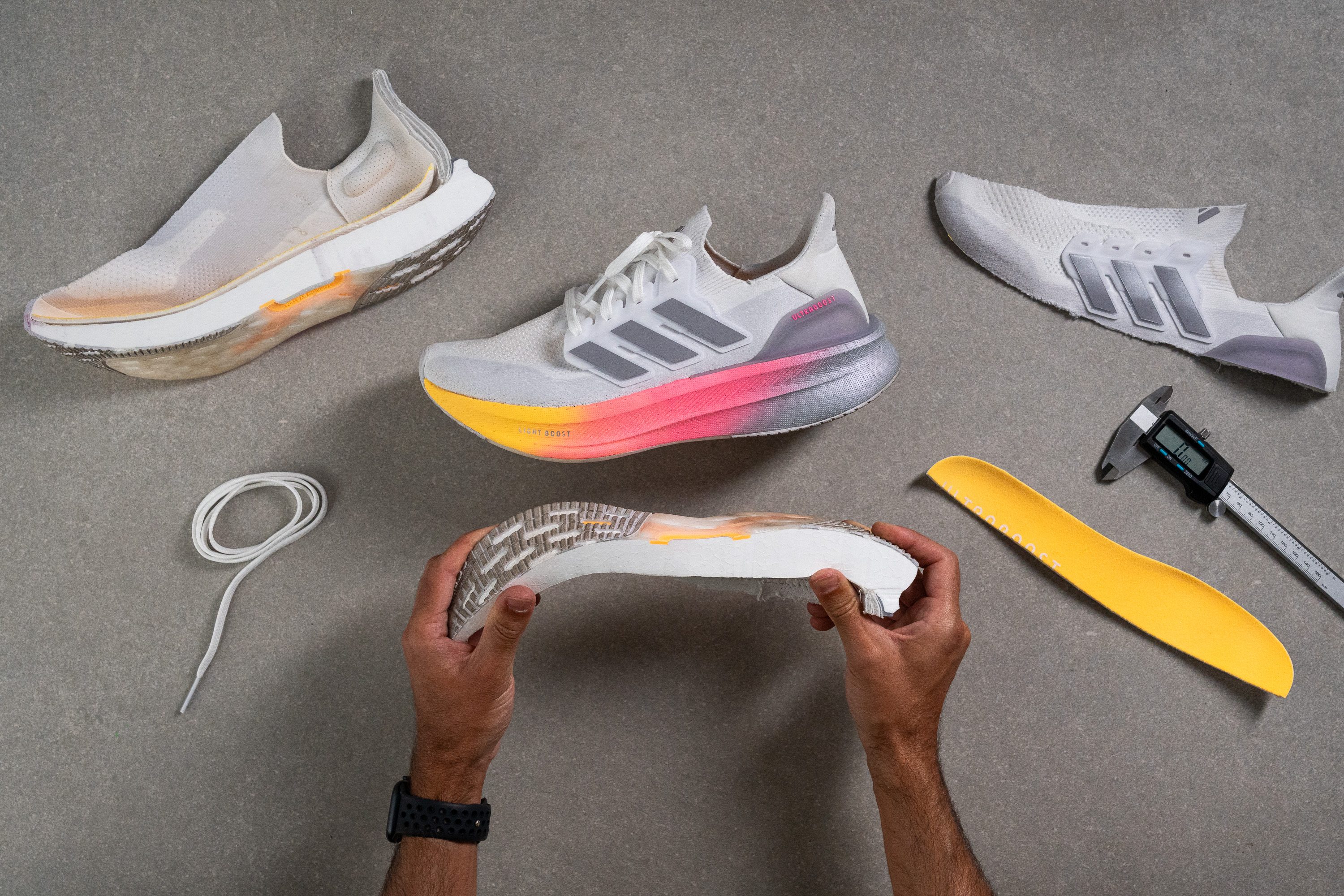
Amortiguación
Shock absorption
La absorción de impactos no es algo que nos preocupe de las Ultraboost 5, pero es que para nada además. Se llevaron un sólido resultado de 126 SA en el talón en nuestra prueba ASTM F1976, que va de la mano con la altura estándar de la suela y hace que estas zapatillas sean lo suficientemente versátiles para hacer un poco de todo: desde salir a trotar un poco hasta enfrentarse a distancias largas.

| Ultraboost 5 | 126 SA |
| Media | 129 SA |
Energy return
La espuma Light Boost nunca decepciona en cuanto a retorno de energía. Como es una espuma de TPU y no de EVA, suele superar a la mayoría de los modelos de entrenamiento diario en cuanto a rendimiento.
Nuestra máquina marcó un 66 % en el talón y un 69,5 % en el antepié, y tanto un resultado como el otro son dignos de mención en esta categoría. Pero claro, teniendo en cuenta lo que cuestan estas zapatillas, la verdad es que nos esperábamos un rendimiento superior a la media.
| Ultraboost 5 | 66.0% |
| Media | 58.5% |
Altura de la suela en la zona del talón
Aunque parece que están súper amortiguadas, en verdad las Ultraboost 5 tienen una suela de altura media en el talón, de 35,2 mm. Creemos que esto es más que suficiente para la mayoría de los corredores, incluso en las carreras largas.
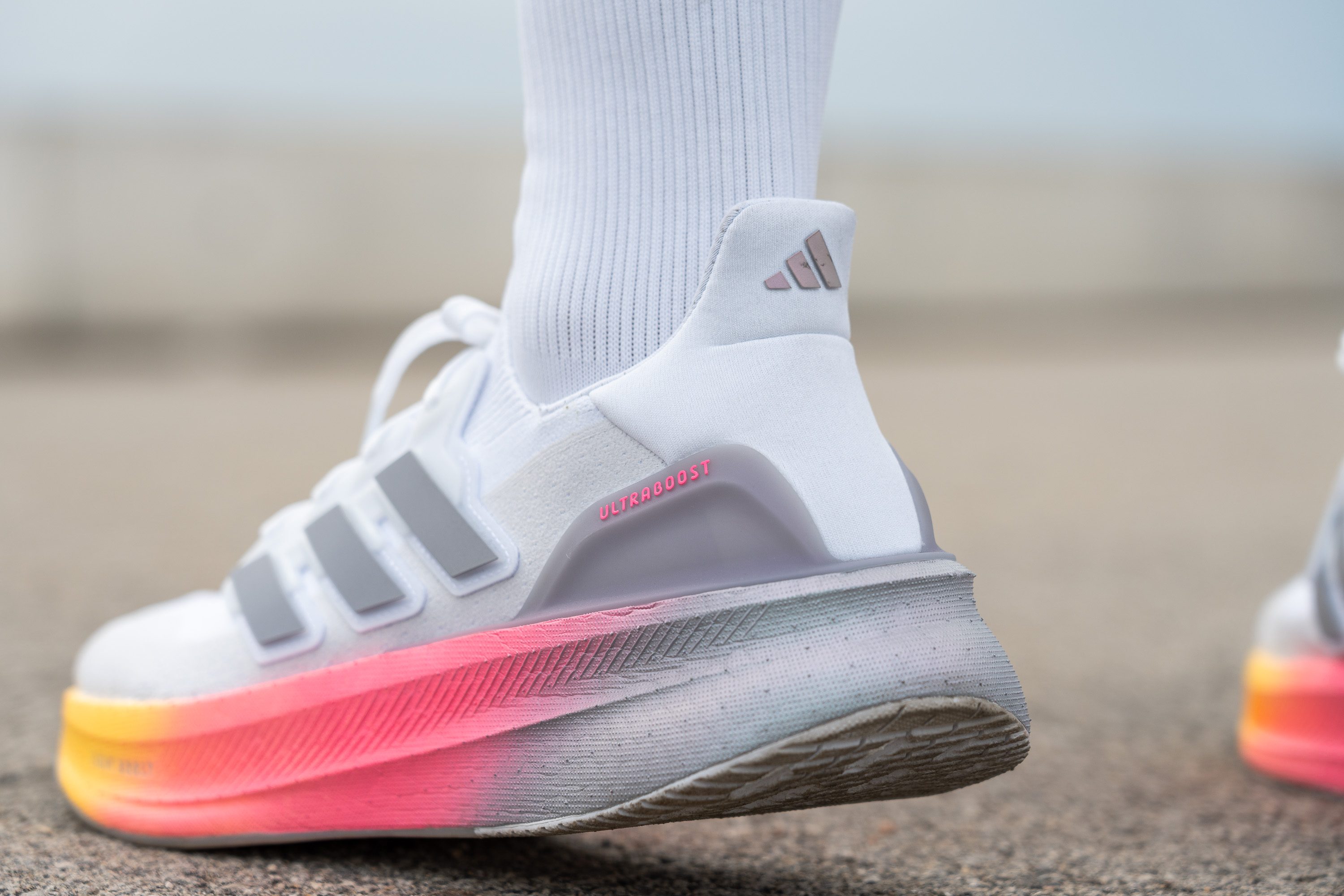
Vamos, que haber hecho esta suela más alta no hubiese tenido ningún sentido. Si estas zapatillas ya están por encima de los 290 g con una suela de 35 mm, imagínate aumentarla a más de 40 mm, ¡se transformarían en un par de lastres para los pies!

| Ultraboost 5 | 35.2 mm |
| Media | 34.8 mm |
Altura de la suela en el antepié
El antepié de las Ultraboost anteriores nos terminó decepcionando en la mayoría de los casos, así que es difícil que podamos recomendarles estas zapatillas a los corredores que no son talonadores.

Sin embargo, descubrimos que Adidas ha hecho una mejora significativa en esta área, aumentando la amortiguación de unos meros 18,2 mm en las Ultraboost Light a unos fantásticos 24,6 mm en este modelo. Es una mejora muy necesaria que apreciamos un montón, aunque no llega a las mejores medidas de algunos pares de Adidas, que alcanzan los 39/29 mm.

| Ultraboost 5 | 24.6 mm |
| Media | 26.2 mm |
Drop
La marca afirma que las Ultraboost 5 tienen un drop de 10 mm, así que lo hemos comprobado en nuestro laboratorio. Siguiendo las directrices oficiales de la World Athletics, lo medimos con nuestros calibres y nos dio 10,6 mm, ¡que es casi lo mismo! Nos quedamos muy contentos con este resultado, ya que una diferencia de solo 0,6 mm apenas es perceptible.
Con este drop nos queda totalmente claro que las Ultraboost 5 están diseñadas para los talonadores. Sin embargo, desde nuestro punto de vista, el aumento de la amortiguación las convierte en una opción sólida para todo tipo de corredores.
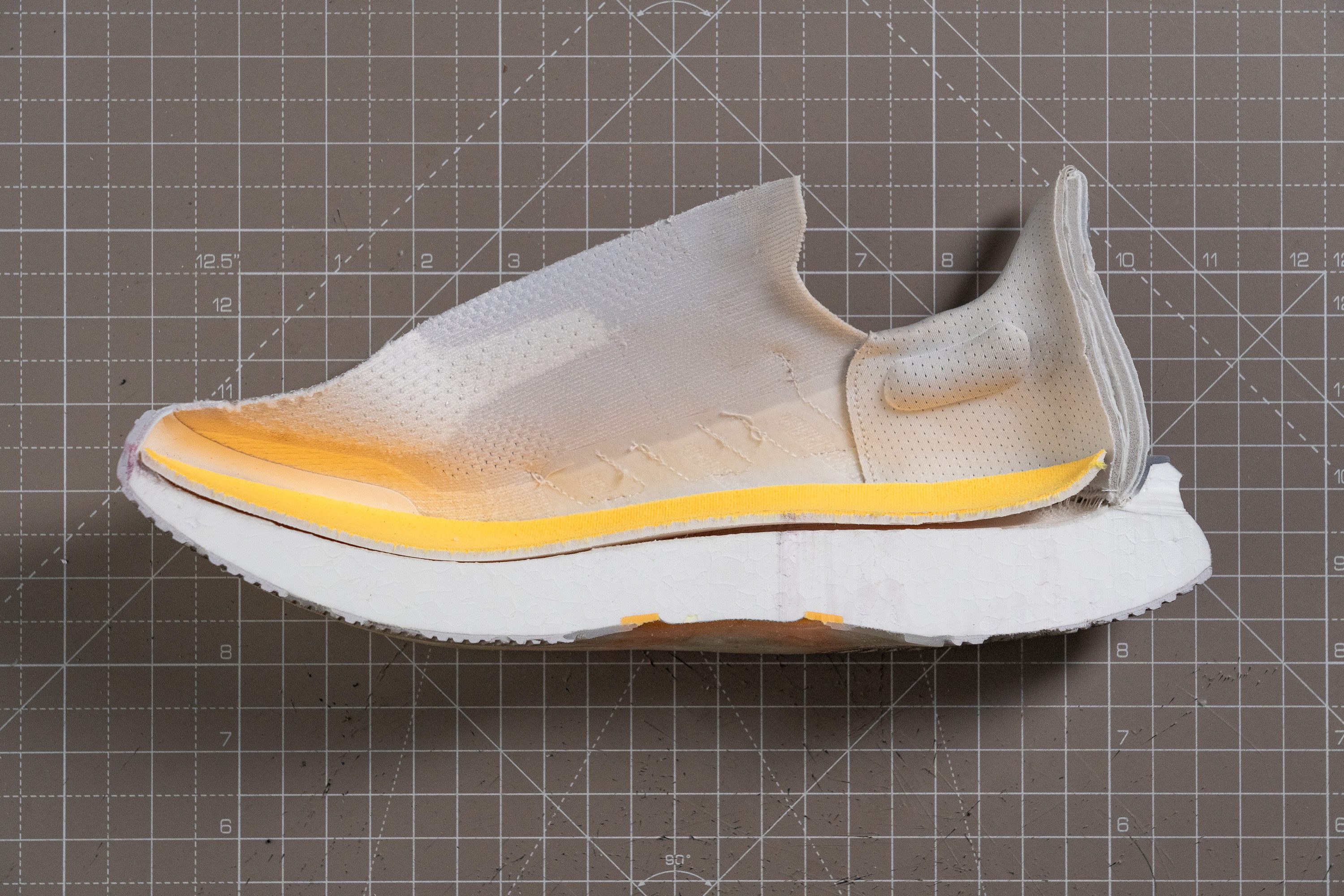
| Ultraboost 5 | 10.6 mm |
| Media | 8.6 mm |
Suavidad de la mediasuela
Desde 2015 hasta 2023, Adidas ha confiado en su espuma Boost en la gama Ultraboost, de ahí su nombre. Al principio, Boost fue una innovación increíble pero, con los años, su peso se convirtió en un gran inconveniente. Por eso nos alegramos cuando la marca introdujo (por fin) la Light Boost, aunque llegó un poco más tarde de lo que esperábamos.
La nueva espuma Light Boost no solo es un 30 % más ligera que la Boost original, sino que también es un poco más blanda. Lo hemos comprobado con nuestro durómetro, ya que las Ultraboost 1.0 obtuvieron una puntuación de 19,9 HA, y la Light Boost de las Ultraboost 5 se llevó un resultado de 17,0 HA, una diferencia pequeña pero que se puede sentir bajo los pies.
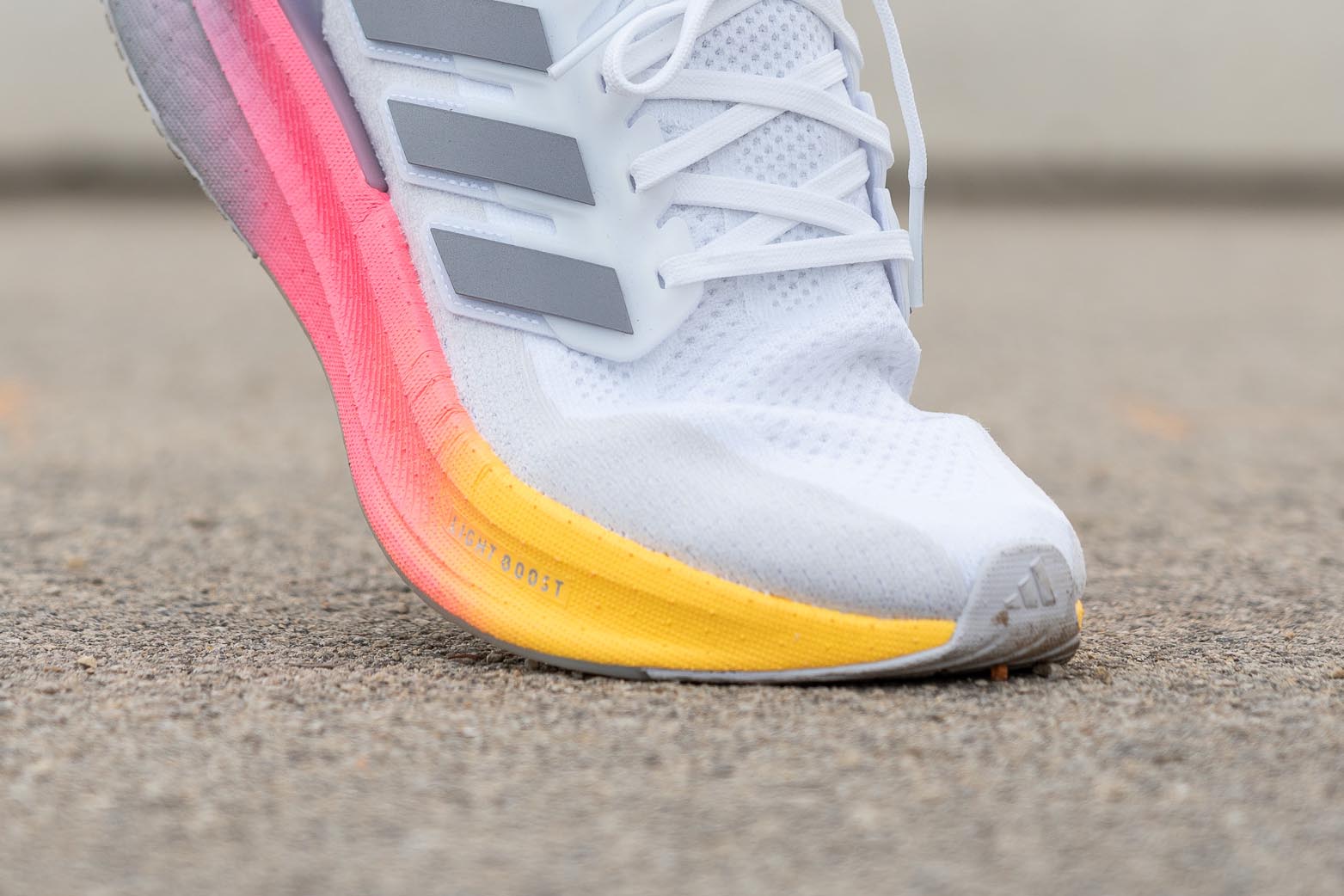
Sin embargo, lo que no ha mejorado es el retorno de energía. Desde nuestro punto de vista, no hay que esperarse milagros de las Ultraboost 5. Aunque esta espuma tiene más rebote que la EVA (que es algo que nos esperábamos de unas zapatillas con este precio), no está ni de lejos al nivel de las superzapatillas de entrenamiento de élite como las ASICS Superblast 2.
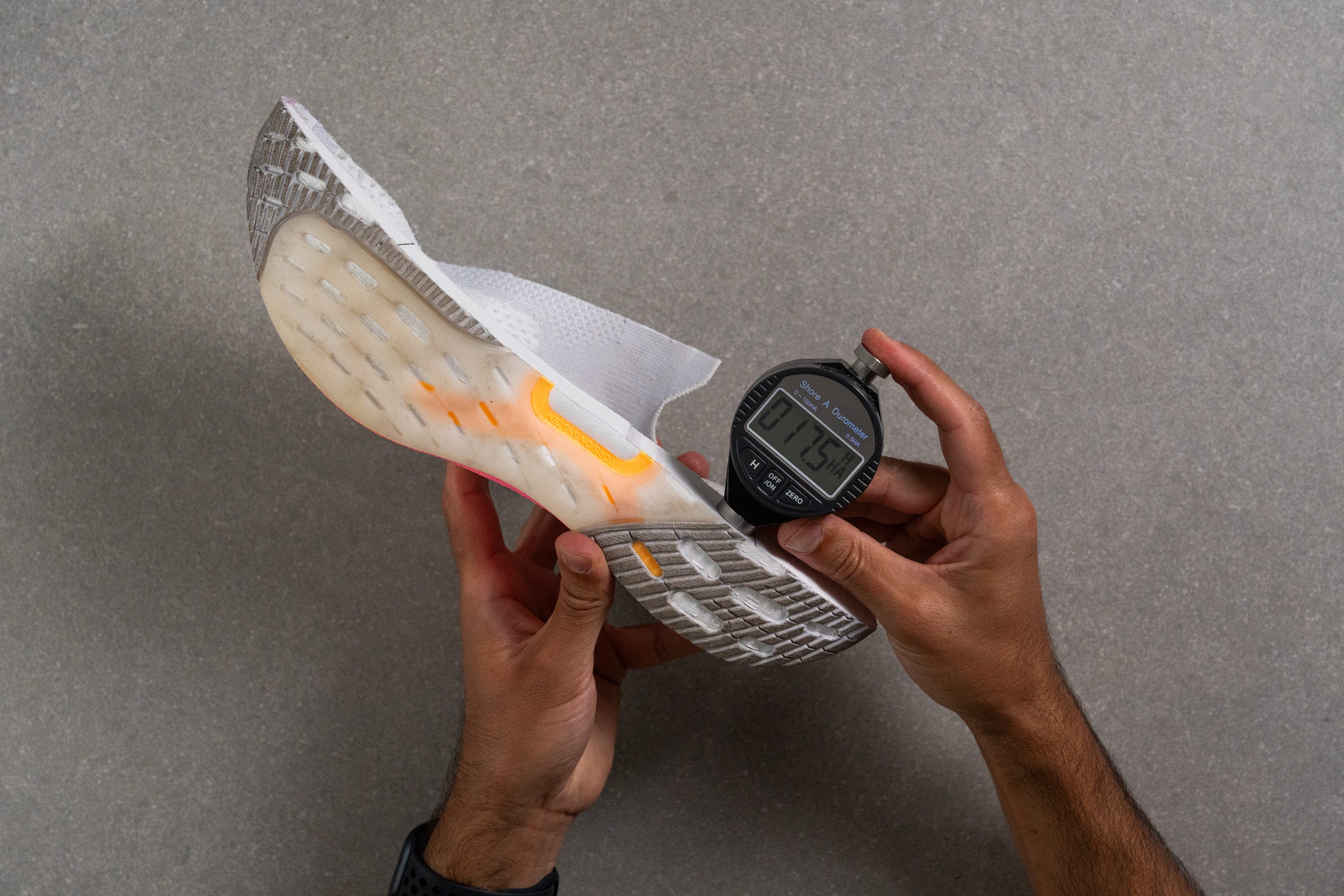
| Ultraboost 5 | 17.0 HA |
| Media | 20.4 HA |
Rocker
Puede que la tendencia actual en el diseño de las zapatillas de running esté protagonizada por un rocker marcado en la parte delantera, pero las Ultraboost 5 se mantienen fieles a un estilo clásico y más plano. Estamos encantados con eso porque las hace perfectas para salir a correr a diario, así como lo suficientemente versátiles como para hacer las actividades del día a día, tanto si vas al gimnasio como si te toca hacer la compra.
Tallaje y ajuste
Talla
Las Adidas Ultraboost 5 tallan bien (89 votos).
Anchura / Ajuste
Adidas probó los dos extremos con las dimensiones entre las estrechas Ultraboost 1.0 y las anchas Ultraboost Light. Por eso no estábamos seguros de qué dirección tomaría con las Ultraboost 5.
Después de medir cuidadosamente el molde de gel con nuestros calibres, estamos encantados de poder decirte que estas zapatillas son muy anchas y espaciosas, alcanzando unos generosos 98,4 mm. Son muy buenas noticias para las personas con pies anchos aunque, a su vez, son malas noticias para los corredores con pies estrechos.
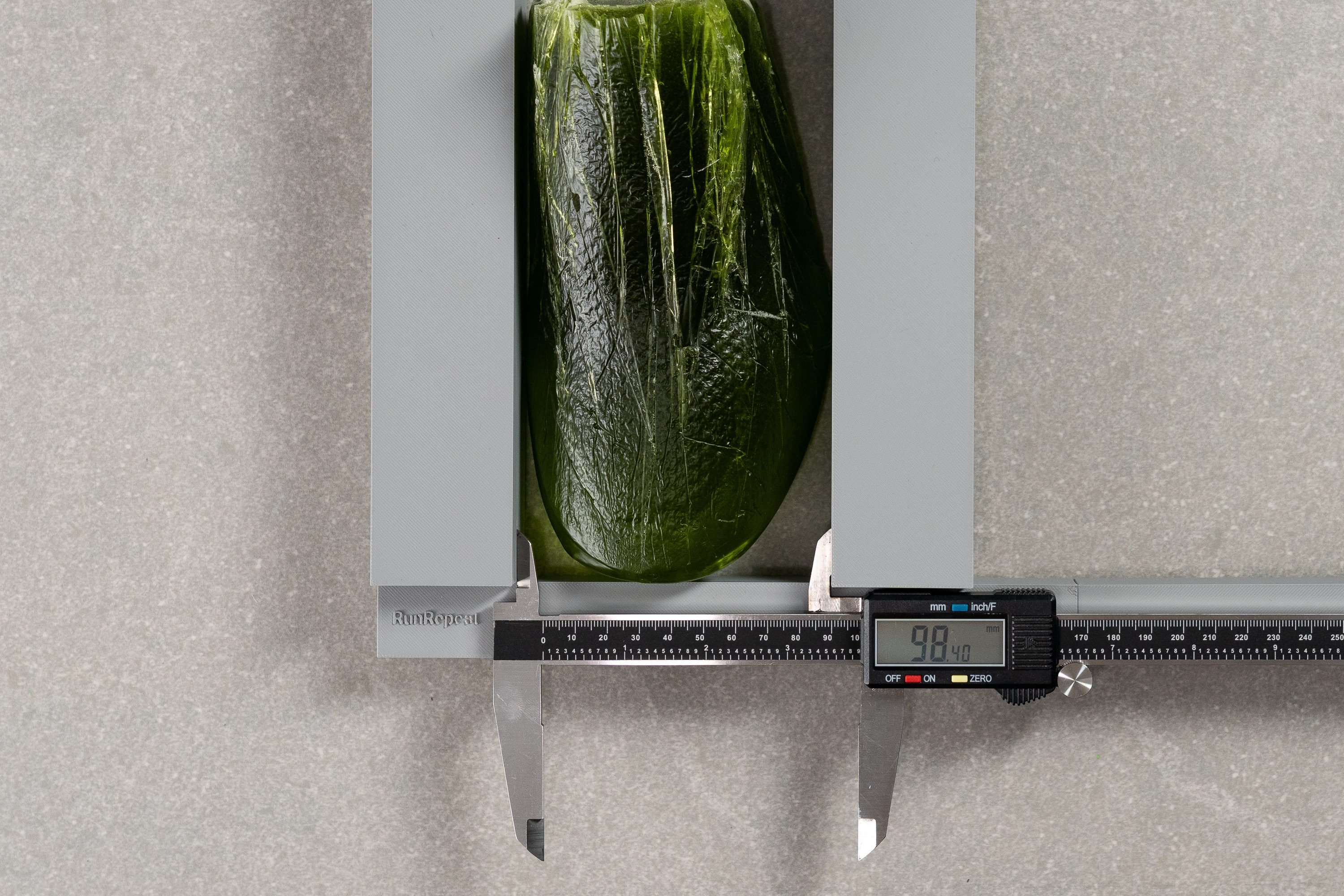
| Ultraboost 5 | 98.4 mm |
| Media | 95.1 mm |
Anchura de la parte delantera
Medimos la anchura en la marca del dedo gordo para ver si este modelo se estrechaba hacia la punta, pero nos encontramos con unos espaciosos 78,6 mm.
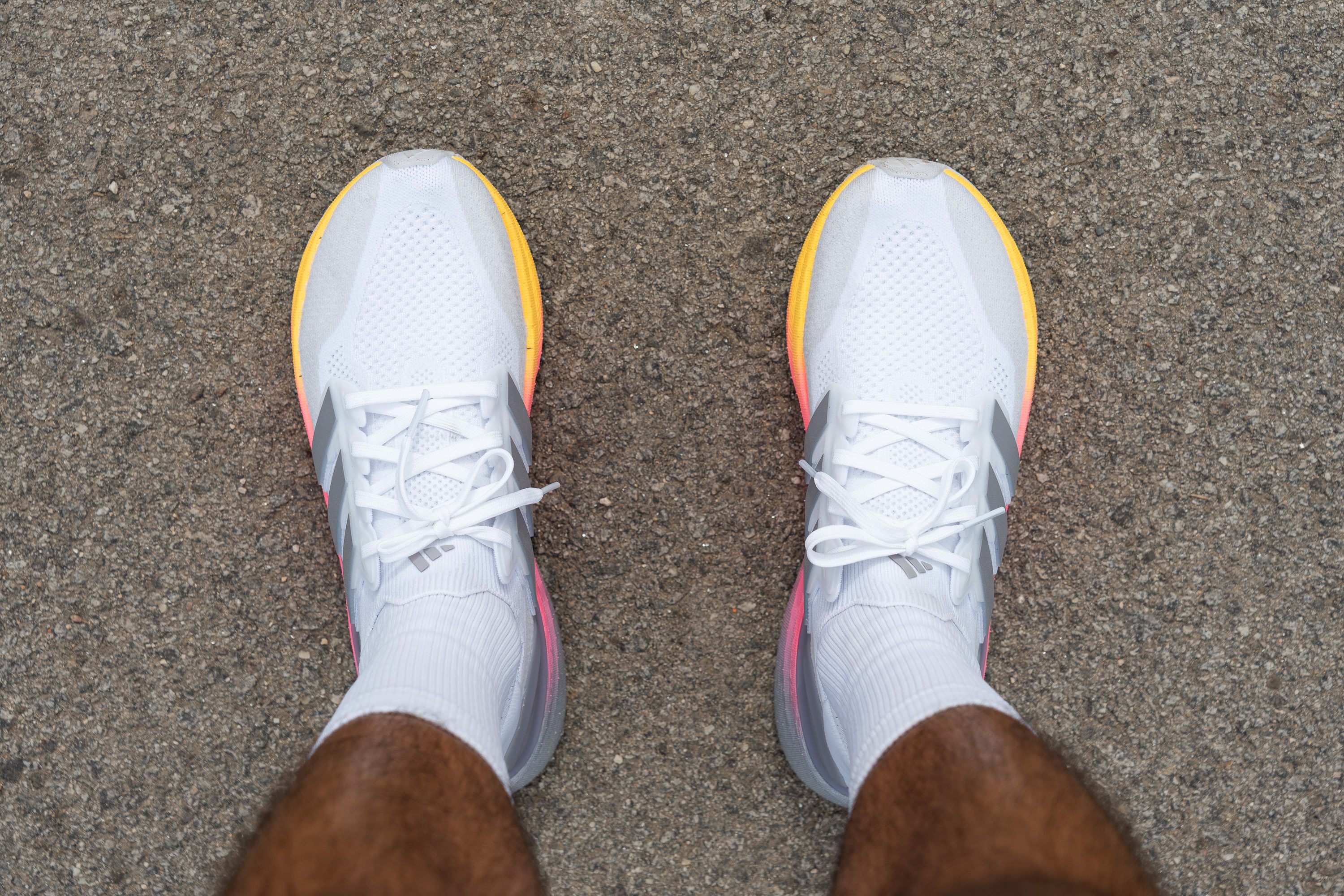
Esto confirma nuestra experiencia al correr con las Ultraboost 5: puedes separar mejor los dedos, sobre todo gracias a su parte superior Primeknit hiperelástica.
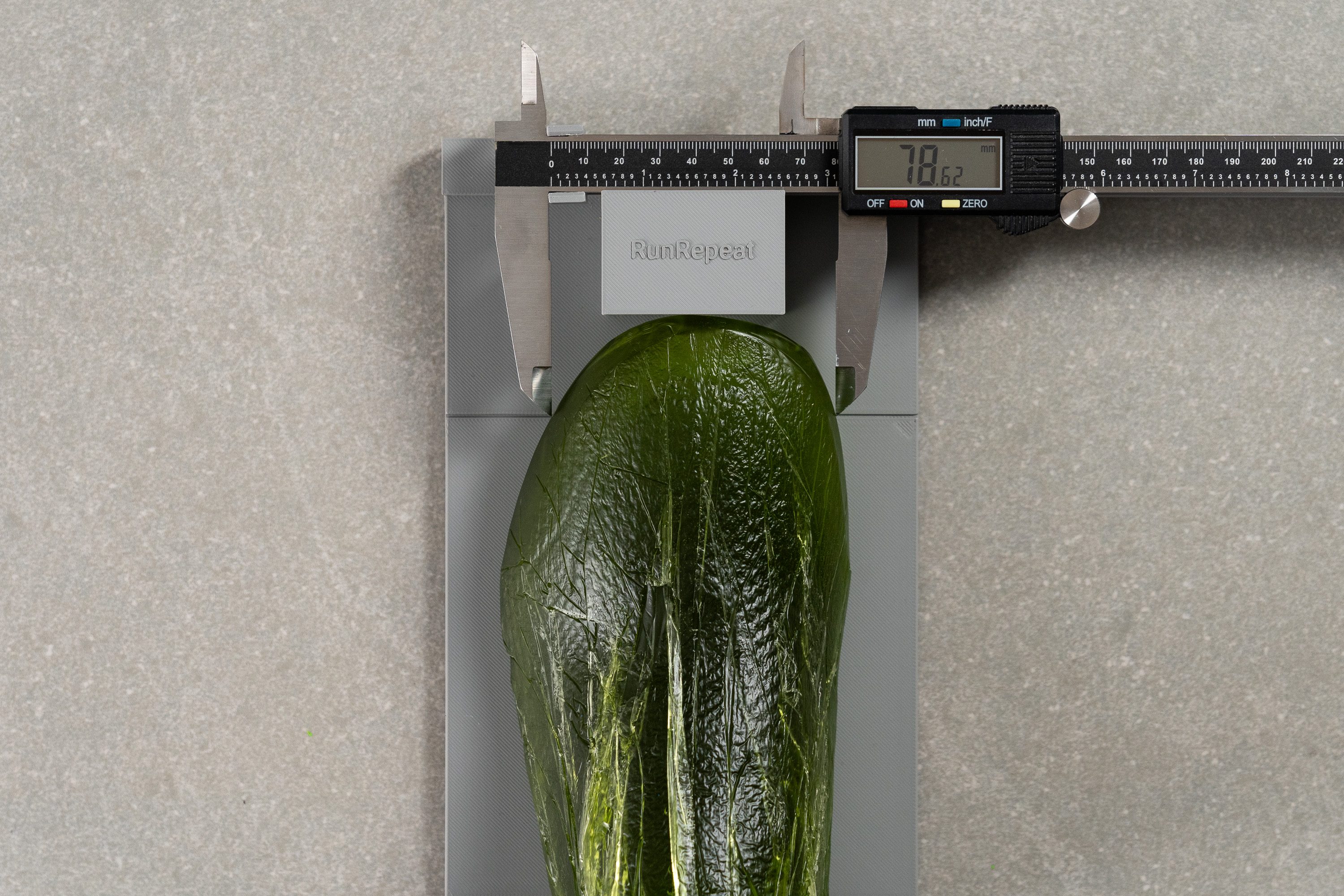
| Ultraboost 5 | 78.6 mm |
| Media | 73.2 mm |
Altura de la parte delantera
Su espacio vertical tampoco está nada mal, ya que nuestro calibre marcó 27,9 mm. Esto puede mejorar después de unas semanas gracias al material elástico del upper.
Basándonos tanto en nuestras medidas y datos, estamos convencidos de que las Ultraboost 5 son la versión con el diseño más espacioso hasta la fecha.
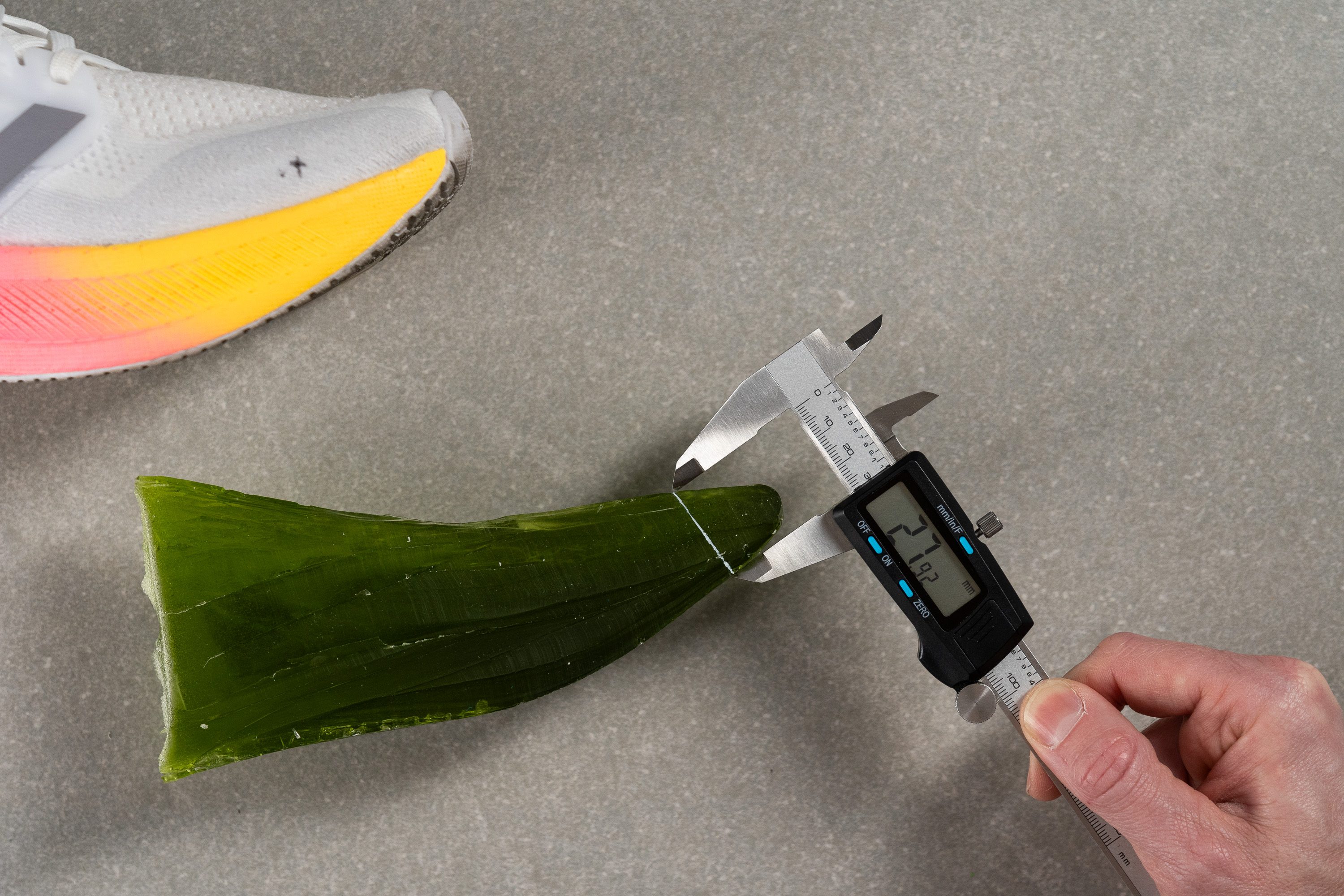
| Ultraboost 5 | 27.9 mm |
| Media | 27.1 mm |
Tracción / Agarre
Traction test
Una de las características más destacadas que hicieron que las Ultraboost 1.0 fuesen tan populares fue su excelente suela exterior Continental, que ofrecía un buen agarre y una durabilidad impresionante. Descubrimos que Adidas ha continuado su colaboración con este fabricante alemán de neumáticos para coches en las Ultraboost 5, así que en el laboratorio teníamos expectativas muy altas.
Después de fijar las UB5 a nuestra máquina de tracción, marcó 0,46, un resultado que está en torno a la media. Esto garantiza un buen agarre tanto en suelo seco como mojado, aunque nos esperábamos un poco más de Conti.
| Ultraboost 5 | 0.46 |
| Media | 0.48 |
Diseño de la suela exterior
Las Ultraboost 5 combinan una cobertura parcial de caucho Continental con pequeñas zonas de espuma expuesta. El caucho se concentra en el antepié y en el talón, mientras que el mediopié utiliza un compuesto más ligero y translúcido que hizo que el agarre que medimos en el laboratorio no fuera tan impresionante.
Esta foto también nos enseña el sistema de torsión amarillo que hay bajo la suela exterior, una característica clave que aumenta la rigidez y ayuda a controlar los movimientos excesivos en las transiciones del pie.
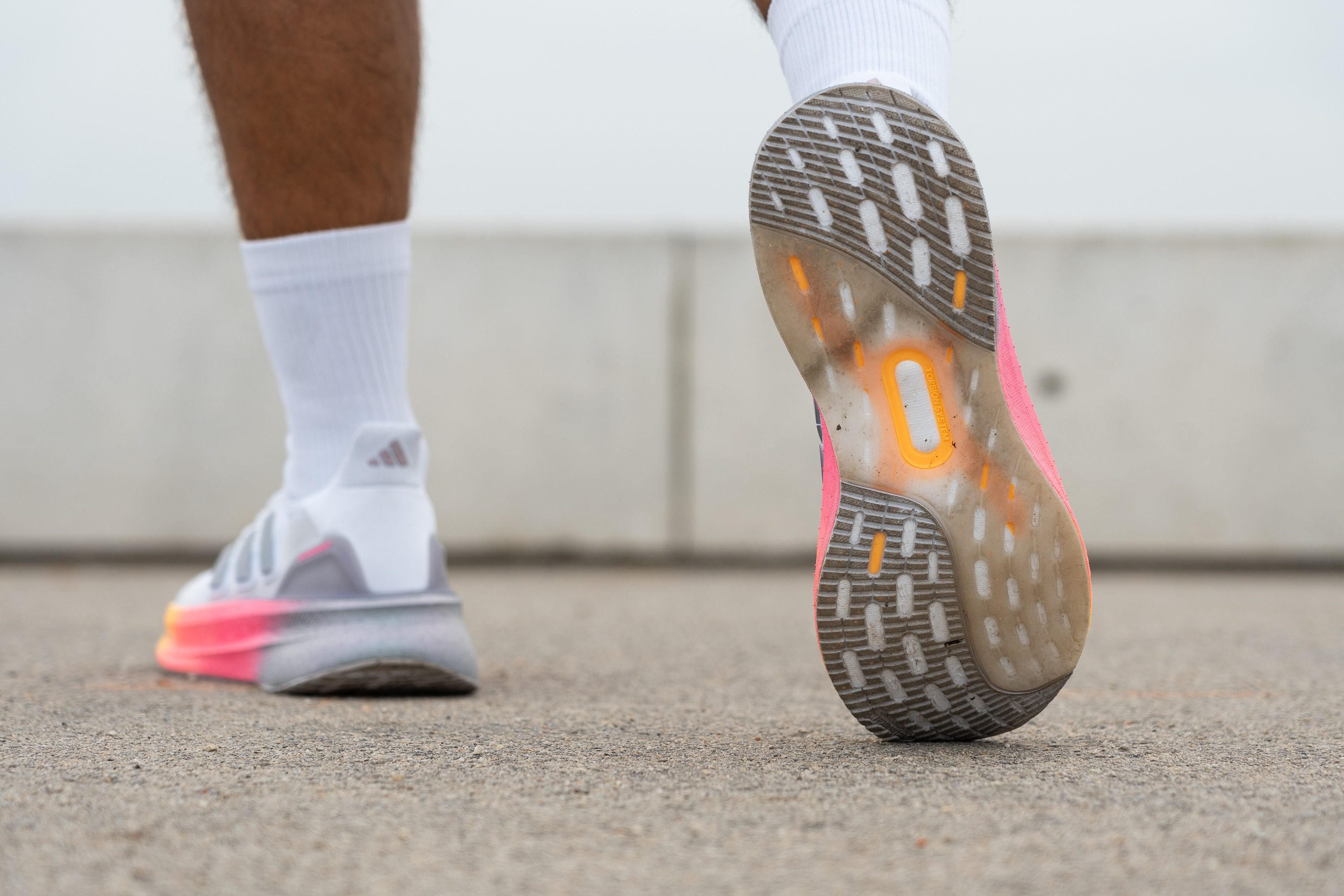
Flexibilidad / Rigidez
Las Ultraboost siempre han hecho que haya debate: en un principio estaban diseñadas para correr, pero ese diseño tan chulo que tienen hizo que se popularizasen como zapatillas tipo lifestyle después de que Kanye West se pusiese la versión totalmente blanca los Premios Billboard de 2015.
Sin embargo, cada vez que sale una versión nueva se vuelven más rígidas, con su sistema Torsion System actualizado y yendo más hacia el rendimiento que hacia un uso casual. De hecho, las Ultraboost 5 incluso superaron a la media en nuestra prueba de flexión de 30 grados, ya que necesitaron 17,3 N para doblarse... por lo que son el modelo que menos se parece a unas sneakers que hemos analizado hasta la fecha.
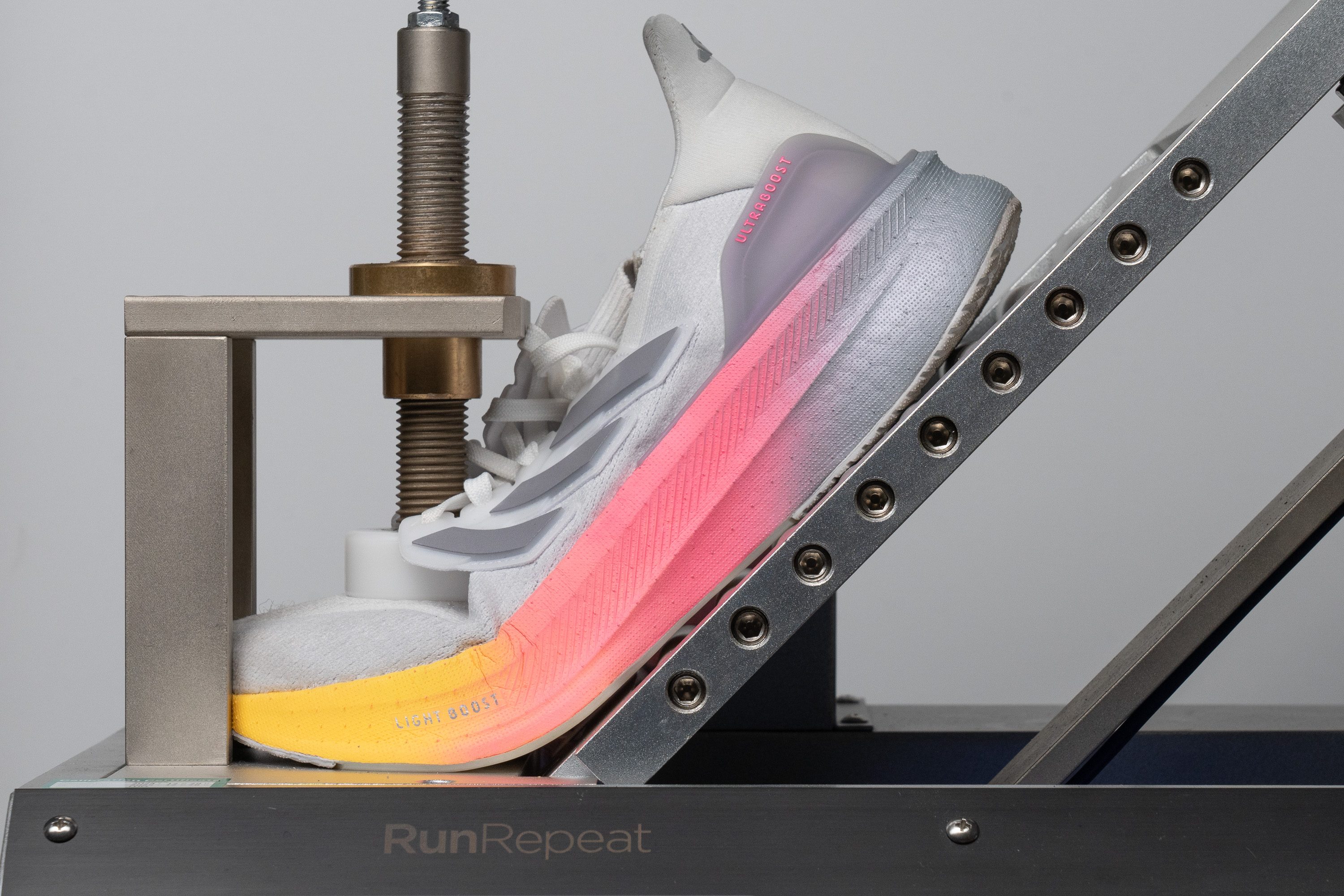
| Ultraboost 5 | 17.3N |
| Media | 15.3N |
Rigidez en frío (%)
La Light Boost nos mostró un rendimiento excepcional en nuestra primera prueba con bajas temperaturas, y estamos encantados de poder decirte que, además de seguir siendo blandas, también siguieron siendo flexibles, volviéndose solo un 19 % más rígidas.
| Ultraboost 5 | 19% |
| Media | 33% |
Peso
Uno de los retos que siempre han estado presentes en las Ultraboost es su relación peso-amortiguación. En la última versión "Light", Adidas abordó esta cuestión haciendo que el peso bajase hasta 305 g, pero en las Ultraboost 5 han conseguido reducirlo incluso más, llegando a los 292 g.
Creemos que esta mejora es muy necesaria, y sin duda apreciamos el esfuerzo de la marca. Sin embargo, creemos que Adidas debería intentar reducir el peso incluso más para que haya más corredores que se interesen por este modelo. ¡Estaremos atentos para ver si lo consigue!
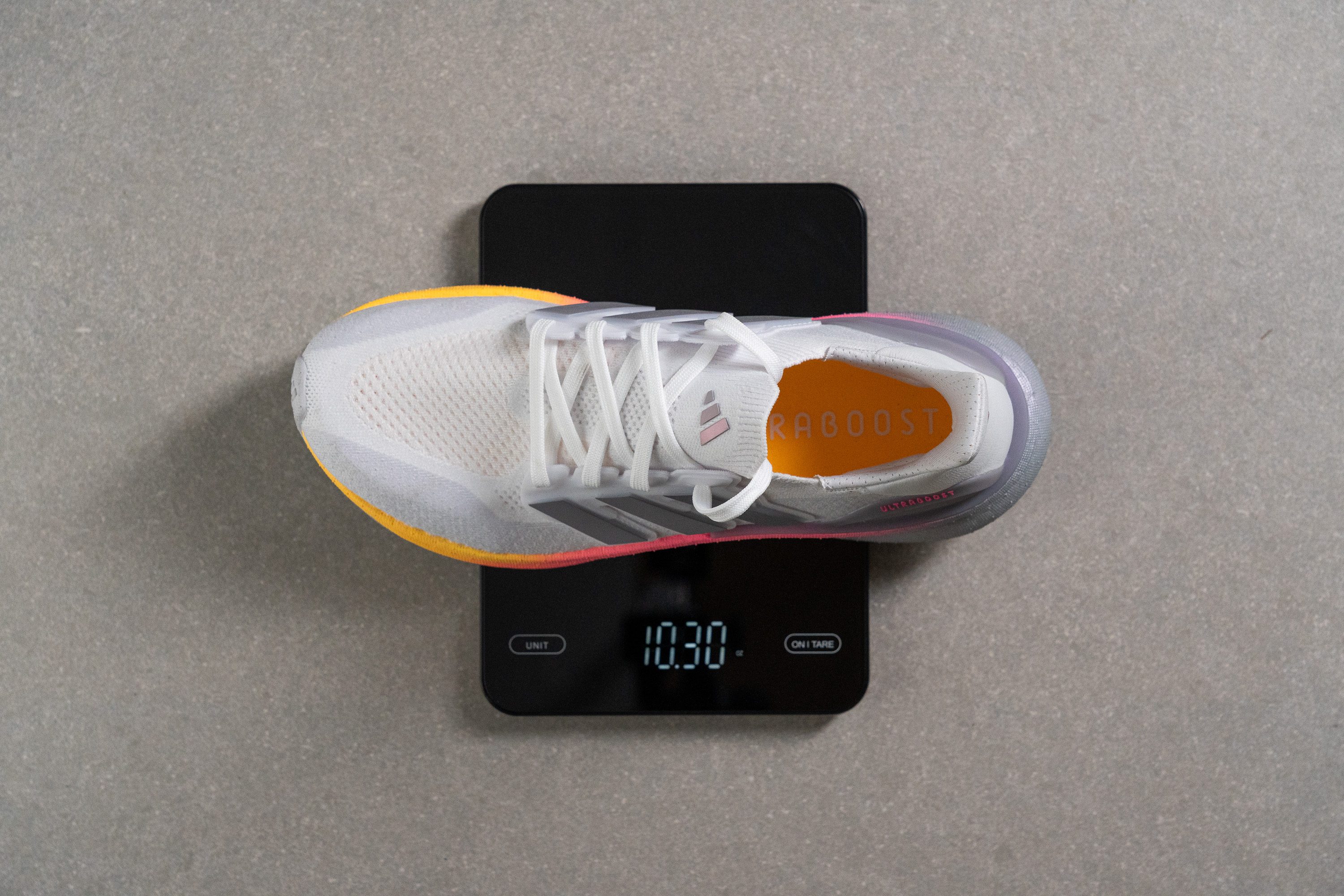
| Ultraboost 5 | 10.3 oz (292g) |
| Media | 9.3 oz (264g) |
Transpirabilidad
Los resultados de nuestro análisis de laboratorio de las Ultraboost Light nos dejaron un poco decepcionados en cuanto a transpirabilidad, ya que se llevaron solo un 3/5.
En cambio, las Ultraboost 5 tienen una parte superior de Primeknit totalmente nueva que, al menos a primera vista, a nosotros nos pareció más transpirable. Pues no veas qué alegría cuando pudimos confirmar, gracias a nuestra prueba de humo, que deja entrar y salir tan bien el aire que se ha llevado un 5/5 perfecto en transpirabilidad.
Al utilizar una luz, nos quedó totalmente claro que Adidas había dado justo en el clavo. Decidió combinar muy hábilmente secciones más gruesas en el lateral de las UB5 con zonas más delgadas y perforadas en la parte delantera y en la lengüeta, y la verdad es que ha funcionado de maravilla tanto para la estabilidad como para la transpirabilidad.

Este alto nivel de transpirabilidad es posible gracias a la nueva parte superior Primeknit. No es tan gruesa como la de las versiones anteriores, y los agujeritos que tiene dejan que el aire caliente salga de las zapatillas sin problema.
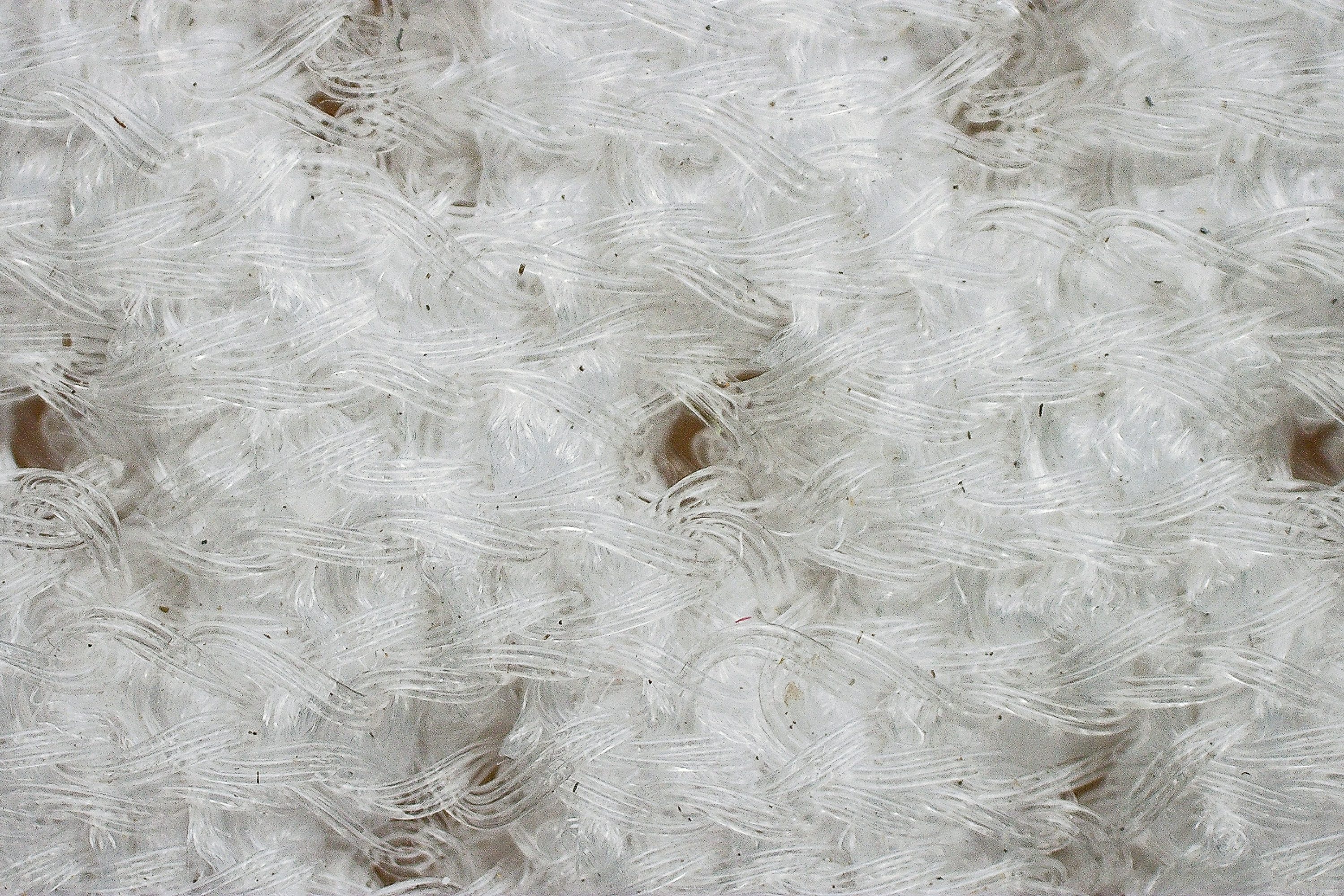
En general, esto es justo lo que nos esperábamos de una parte superior de primera. Es elástica, cómoda, suave, no tiene costuras al ser de una sola pieza y deja que el aire entre y salga sin problemas. En nuestra opinión, es uno de los aspectos más destacados de las Ultraboost 5
| Ultraboost 5 | 5 |
| Media | 3.7 |
Estabilidad
Prueba de estabilidad lateral
La línea Ultraboost siempre ha tenido modelos de running neutros, y las Ultraboost 5 no son una excepción. Por lo tanto, siguen sin ser la mejor opción para los que necesitan estabilidad.
Sin embargo, eso no significa que sean unas zapatillas inestables. La Light Boost no es una espuma superblanda, y la estructura de los cordones, junto con los clips de plástico en el talón, ayudan a asegurar el pie, sobre todo cuando te toca coger una curva.
Rigidez torsional
Nos esperábamos que las Ultraboost 5 consiguiesen una puntuación alta en nuestra prueba de rigidez, básicamente, por la tecnología Adidas Torsion System. Esta pieza de plástico naranja en forma de X le da un extra de rigidez a la mediasuela, aunque no es tan rígida como una placa de carbono.

Desde nuestro punto de vista, el 4/5 que se llevaron en nuestra prueba de rigidez torsional era de esperar. Además, nos dimos cuenta durante nuestras pruebas de uso corriendo con estas zapatillas que la estabilidad añadida se nota bastante. Eso sí, son un poco menos cómodas y menos naturales de lo que nos esperábamos, la verdad.
Al final, cuando se trata de zapatillas de running, ¡es imposible tenerlo todo!
| Ultraboost 5 | 4 |
| Media | 3.5 |
Rigidez del contrafuerte del talón
El contrafuerte del talón tiene el clásico diseño de las Ultraboost que llevamos viendo desde 2015. Descubrimos que incluye dos clips de plástico en los laterales, añadiendo un toque de rigidez que complementa la parte superior flexible y parecida a un calcetín. Esta combinación se tradujo en un resultado medio (3/5) en nuestra evaluación manual y es útil para los talonadores con problemas leves de estabilidad.
| Ultraboost 5 | 3 |
| Media | 2.9 |
Anchura de la mediasuela - antepié
Estas son las mejores Ultraboost que han salido hasta la fecha para los corredores de metatarsos y de mediopié, y como su antepié es más ancho y tiene una suela más alta, la estabilidad y el control han aumentado.
Medimos la anchura del antepié con nuestros calibres digitales y nos dio 115,6 mm.
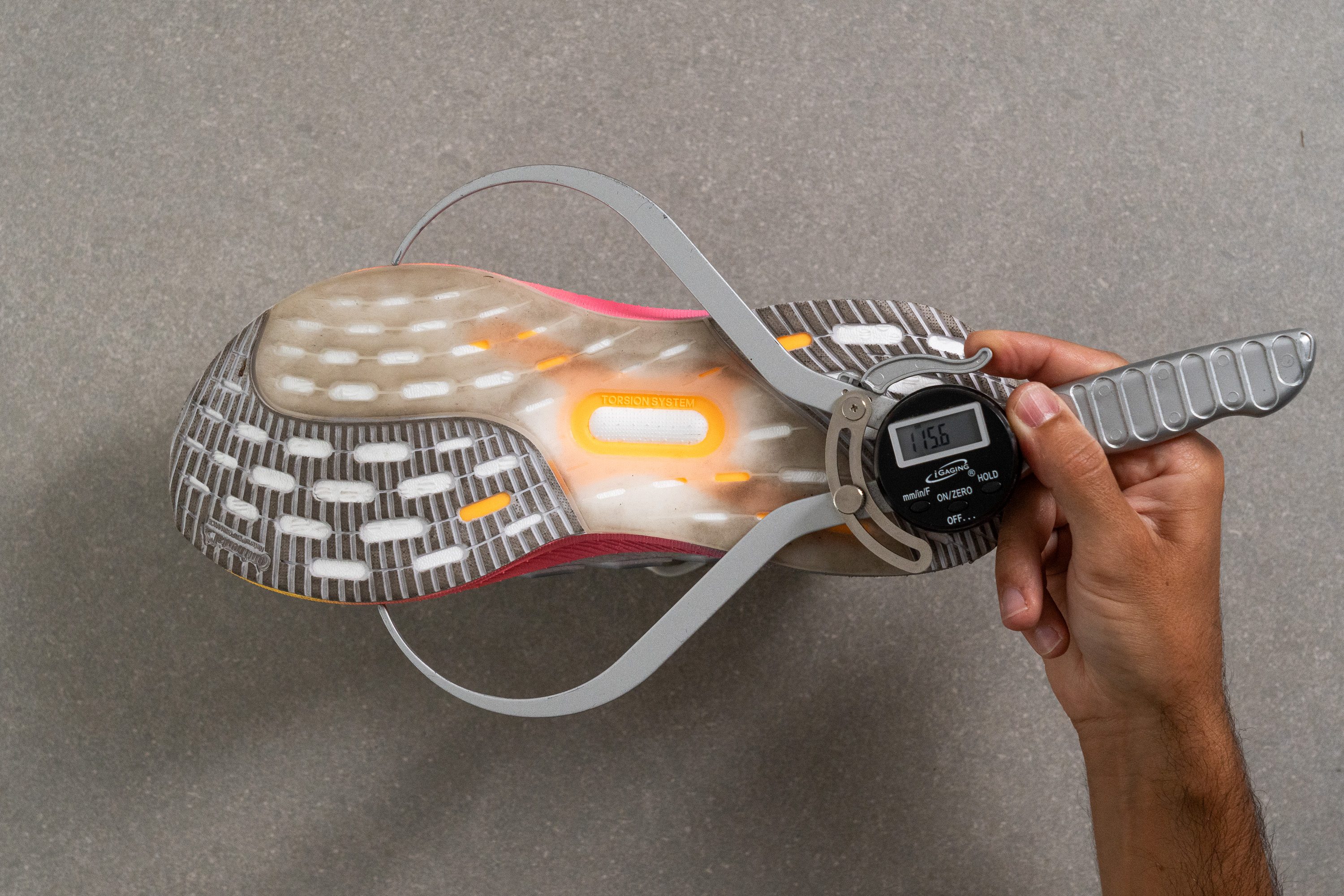
| Ultraboost 5 | 115.6 mm |
| Media | 114.4 mm |
Anchura de la mediasuela - talón
Del mismo modo, descubrimos que las Ultraboost 5 cuentan con el talón más ancho (94,3 mm) de toda su serie hasta la fecha.
Creemos que esta característica, combinada con el Torsion System y los clips de plástico grandes que tienen en los laterales del talón, hace que los talonadores tengan una pisada más centrada y estable que antes.
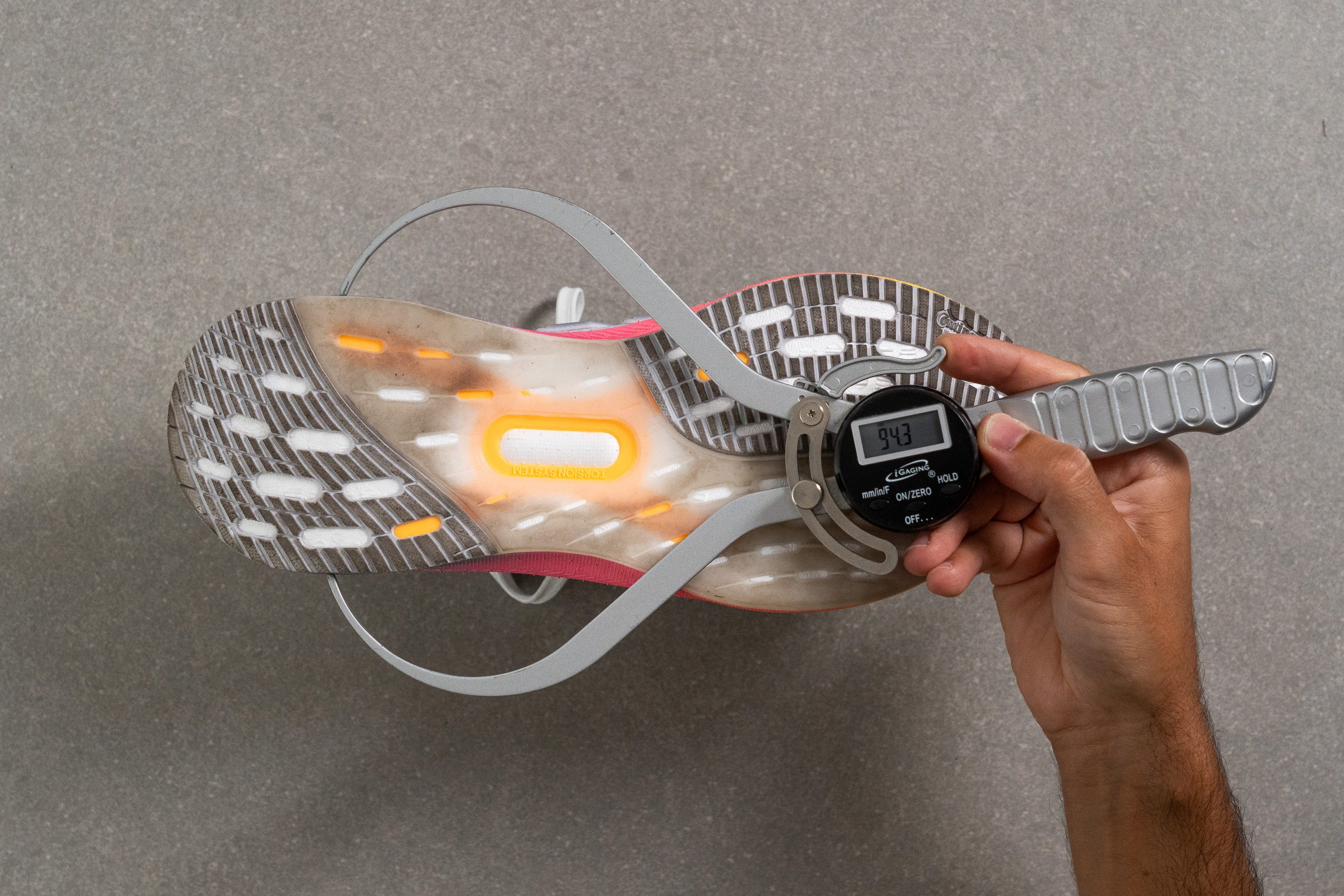
| Ultraboost 5 | 94.3 mm |
| Media | 90.7 mm |
Bisel del talón
En línea con los modelos recientes de Adidas como las Supernova Rise, las Ultraboost 5 tienen un talón biselado que les suaviza las transiciones a los talonadores que carecen de una pisada más centrada.
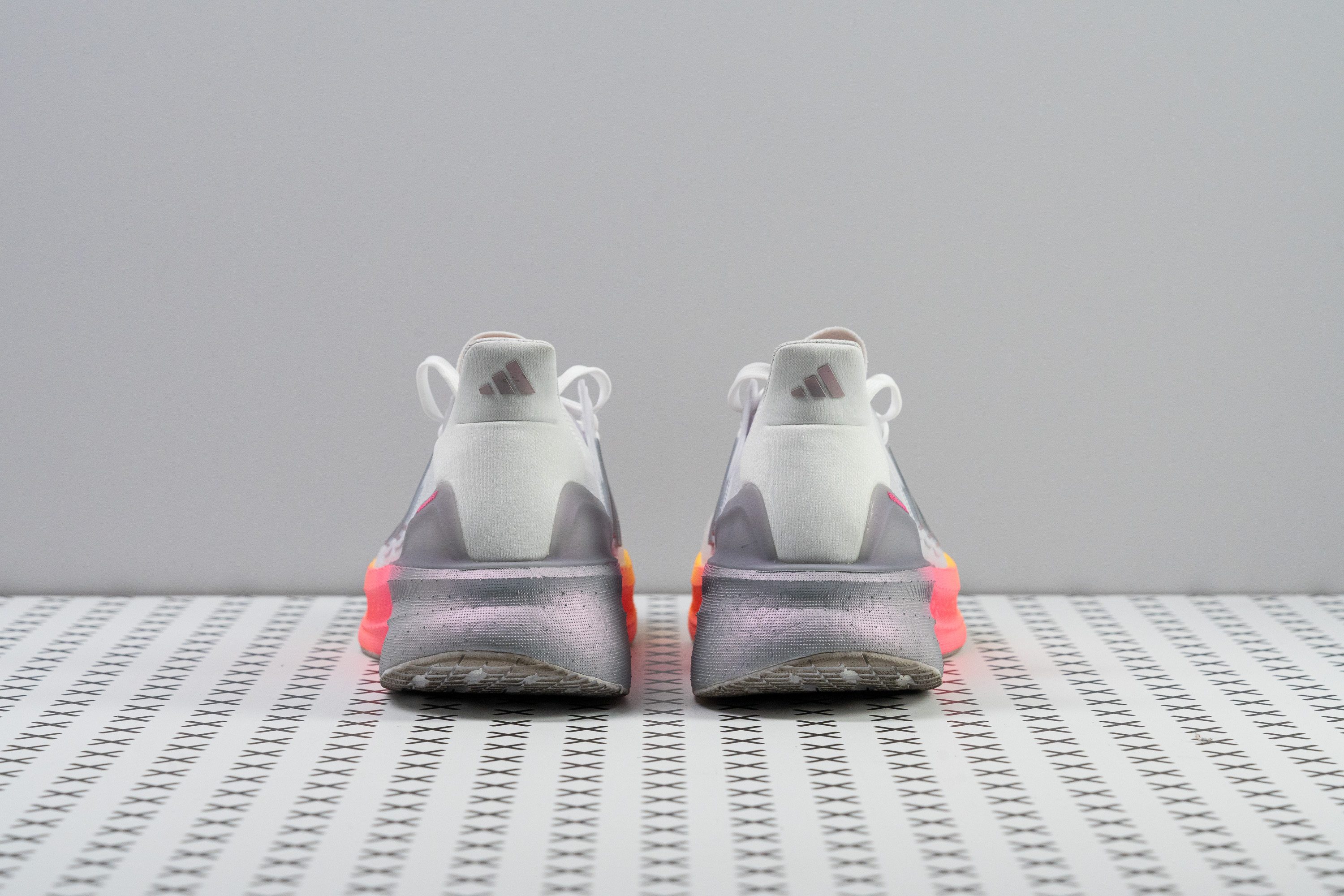
Durabilidad
Durabilidad de la parte delantera
La durabilidad siempre es algo que nos preocupa en el laboratorio cuando vemos unas zapatillas de knit, ya que los hilos más suaves tienden a ser más propensos al desgaste.
Sin embargo, el rendimiento de las UB5 nos sorprendió muy positivamente, ya que nos demostraron ser más resistentes de lo que esperábamos. Según nuestro análisis, su parte superior se llevó un decente 3/5 en durabilidad, así que el Primeknit mostró una gran resistencia a pesar de ser extremadamente transpirable.

| Ultraboost 5 | 3 |
| Media | 2.6 |
Durabilidad del acolchado del talón
Una vez analizamos la parte delantera, nos centramos en el acolchado del talón, que es una parte que preocupa a muchos corredores, sobre todo a los que tienden a desgastarla.
A diferencia de la parte delantera, donde el resultado fue normal y corriente, hemos descubierto que Adidas nos ha demostrado quién manda en el talón. Su acolchado cumple con todos los requisitos de comodidad y durabilidad, así que le hemos dado un merecido 5/5.

| Ultraboost 5 | 5 |
| Media | 3.4 |
Dureza de la suela
Una de las características más destacadas que hicieron que las Ultraboost 1.0 se volviesen increíblemente populares fue su excelente suela exterior Continental, que ofrece un agarre excepcional y una durabilidad impresionante. Descubrimos que la marca ha continuado su colaboración con el fabricante alemán de neumáticos para coches en las Ultraboost 5, así que nuestras expectativas empezaron a subir como la espuma.

Nuestra evaluación inicial se centró en la dureza del caucho, que fue sorprendentemente inferior a la media, con solo 69,1 HC. Esto explica la maravillosa tracción de la que disfrutamos en terrenos distintos, pero también nos plantea dudas sobre la posibilidad de que existan posibles problemas de durabilidad.
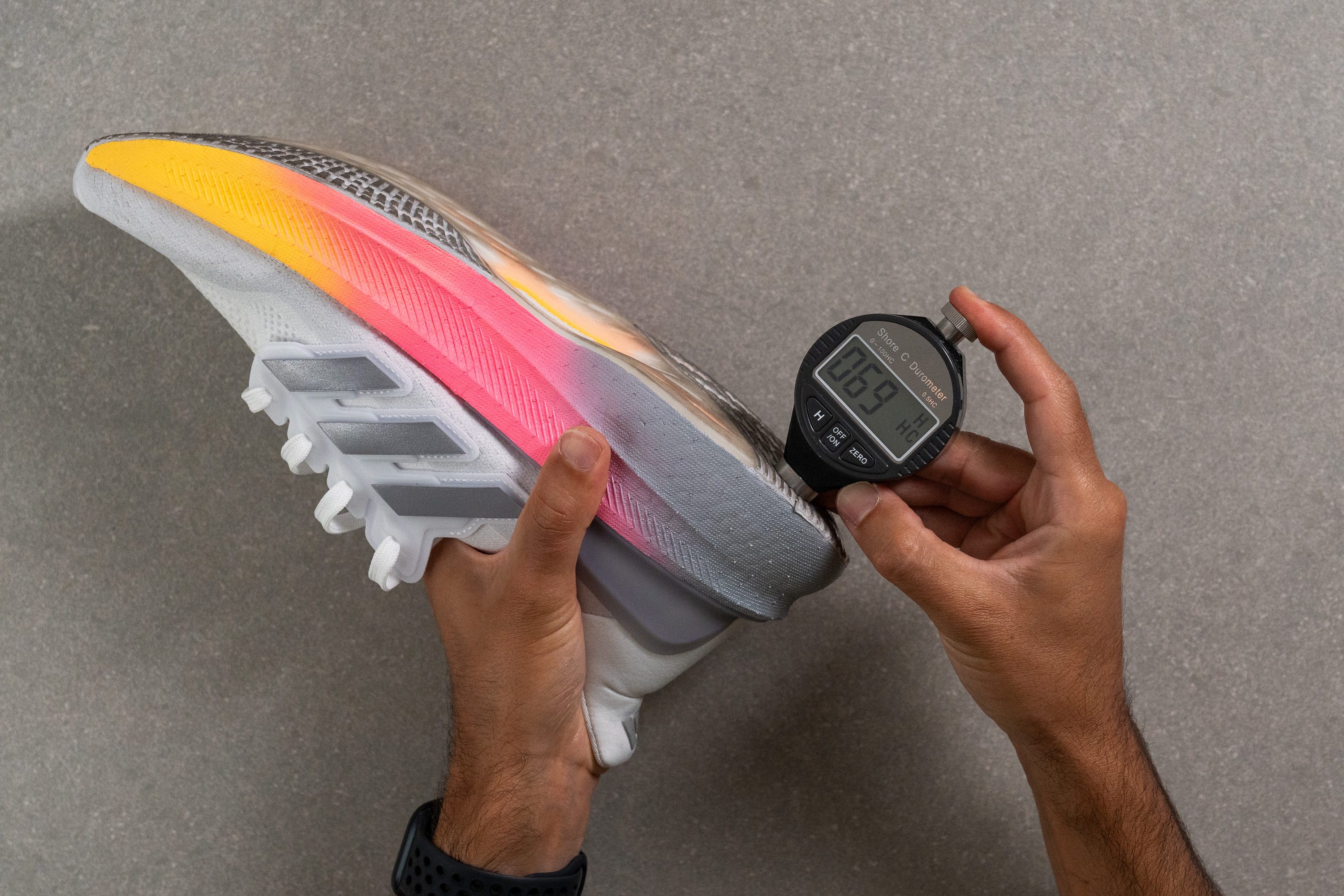
| Ultraboost 5 | 69.1 HC |
| Media | 79.2 HC |
Durabilidad de la suela
Para comprobar si nuestras preocupaciones por la durabilidad estaban justificadas, hicimos una última prueba utilizando nuestro Dremel.
Y la verdad es que los resultados nos dejaron boquiabiertos: la resistencia del caucho Continental es extraordinaria. Los daños fueron de solo 0,8 mm, y aunque pueda sonar a que es una cifra estándar, haznos caso, ¡es un resultado impresionante para un caucho tan blando!
| Ultraboost 5 | 0.8 mm |
| Media | 1.1 mm |
Grosor de la suela
Toda la confianza que teníamos en la durabilidad de la suela exterior hizo que su grosor de 2,8 mm nos pareciese más que suficiente para estas zapatillas.

Según nuestra evaluación, parece que la mayoría de los corredores probablemente desgastarán otras partes de las Ultraboost 5 antes de que la suela exterior muestre un desgaste importante.
| Ultraboost 5 | 2.8 mm |
| Media | 3.2 mm |
Varios
Grosor de la plantilla
La plantilla es bastante más fina de lo que solemos ver en las zapatillas para correr a diario, ya que solo mide 3,1 mm.
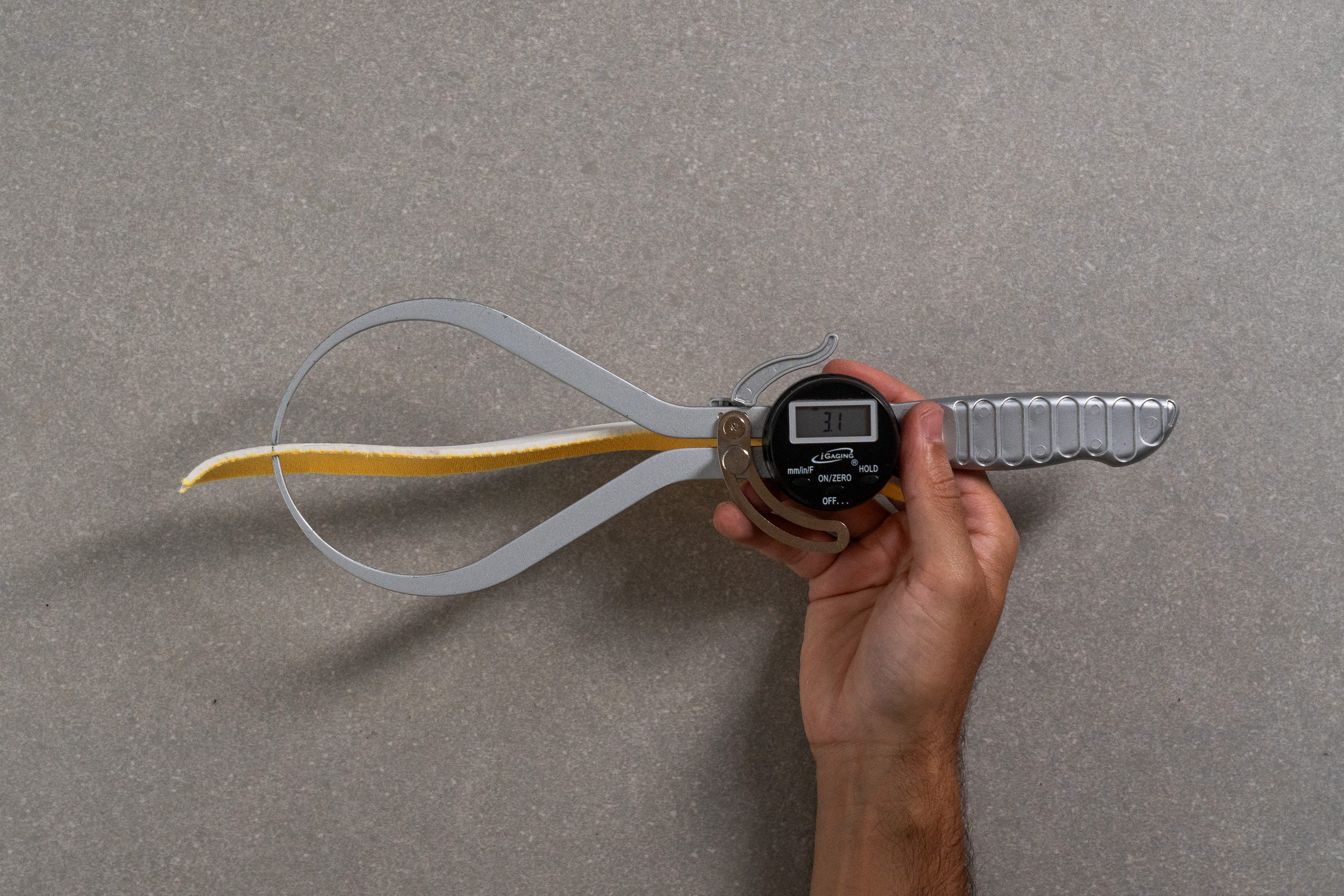
| Ultraboost 5 | 3.1 mm |
| Media | 4.5 mm |
Plantilla extraíble
Cambiar la plantilla por una más gruesa es facilísimo, y las medidas que tomamos de la parte delantera indican que hay espacio suficiente para ello.
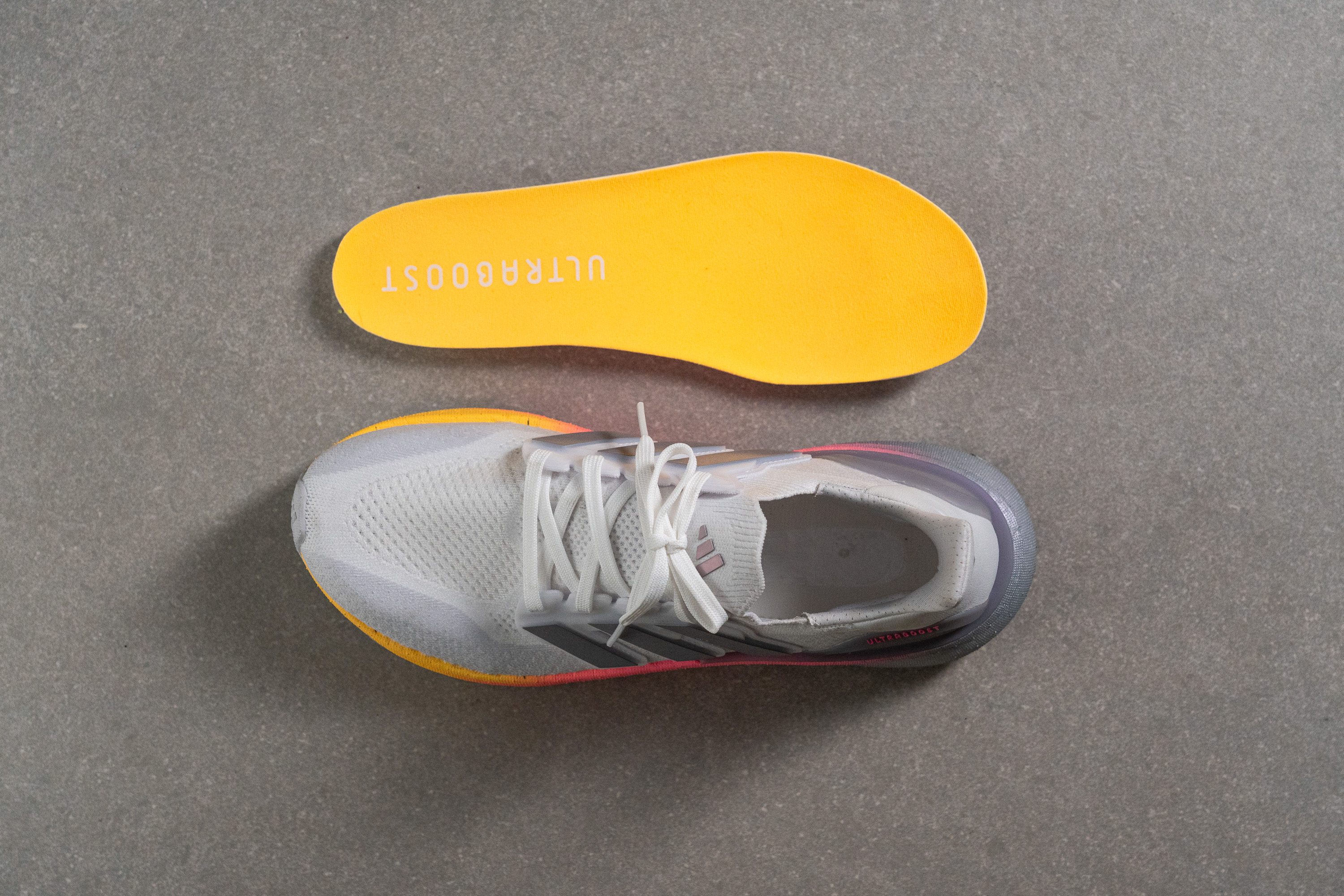
| Ultraboost 5 | Sí |
Rigidez de la mediasuela en frío (%)
El componente principal de la Light Boost no es EVA, sino TPU. Como resultado, su rendimiento es bastante mejor a bajas temperaturas en comparación con otras espumas más baratas. Después de estar 20 minutos en nuestro congelador, estas zapatillas se volvieron solo un 16,9 % más firmes.

| Ultraboost 5 | 17% |
| Media | 24% |
Elementos reflectantes
Es una pena que Adidas haya optado por no incluir ningún elemento reflectante en sus últimas Ultraboost. Estamos un poco decepcionados, la verdad, porque estas zapatillas valen un ojo de la cara, así que añadirles detalles reflectantes habría sido más que razonable.
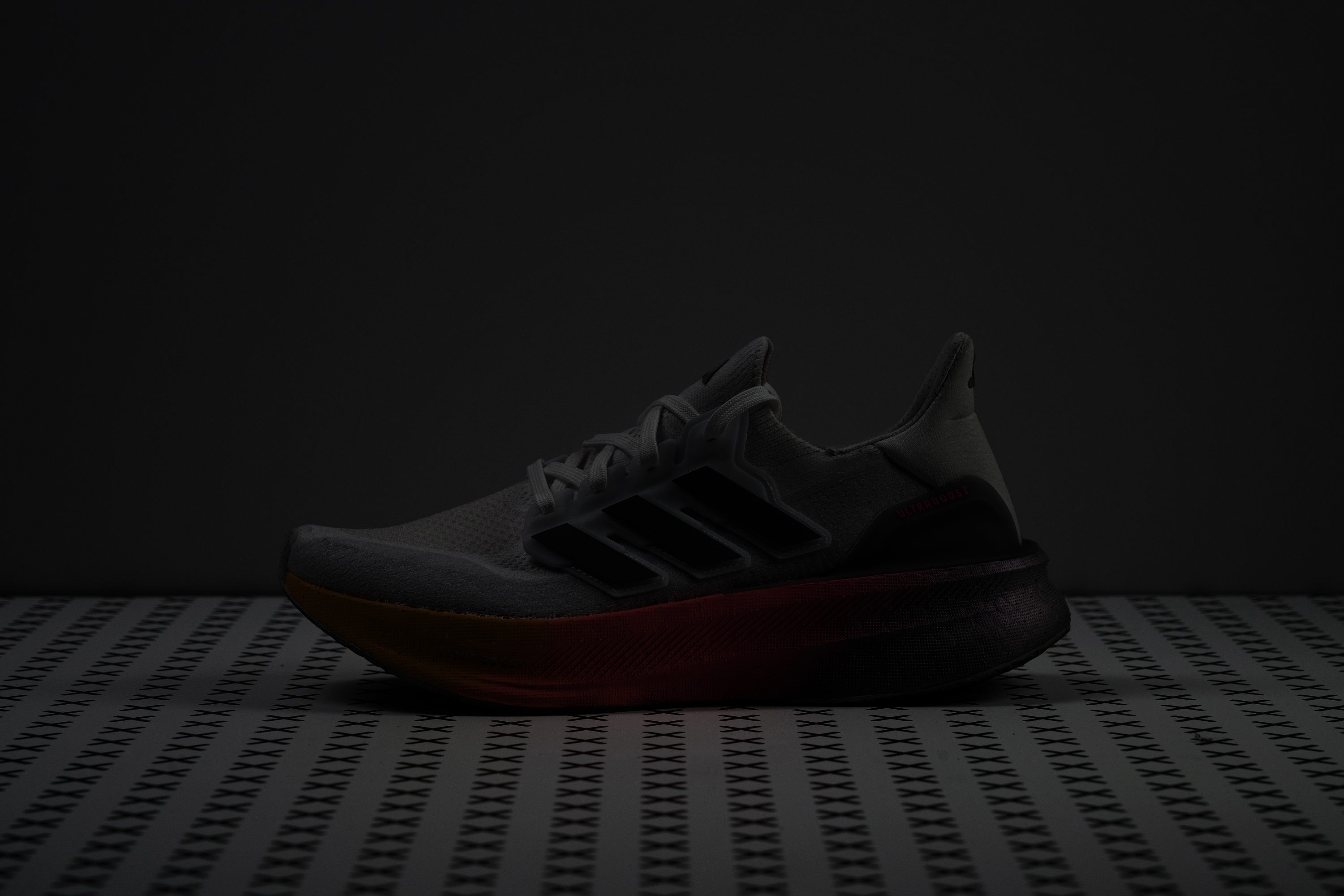
| Ultraboost 5 | No |
Acolchado de la lengüeta
Como en la mayoría de las lengüetas tipo calcetín, el acolchado de las Ultraboost 5 es mínimo, con un grosor de tan solo 1,2 mm, lo que podría ser un problema para los que experimentan molestias o rozaduras en el empeine.
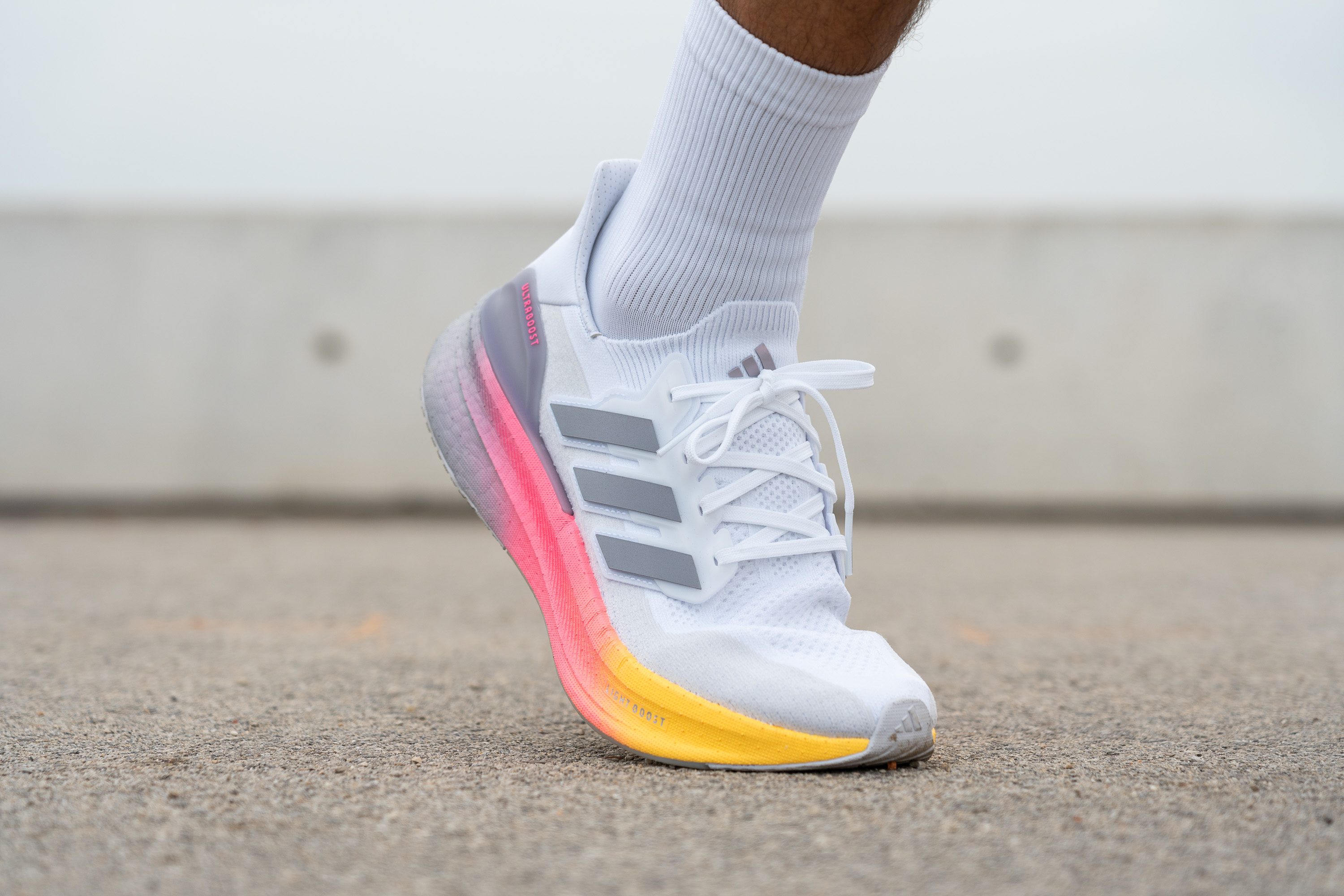
A los que prefieren una lengüeta más mullida, les recomendamos que le echen un ojo a las ASICS Nimbus 26. Tienen mucha amortiguación, una parte superior de knit supercómoda, y una lengüeta más acolchada para mejorar la comodidad.
| Ultraboost 5 | 1.2 mm |
| Media | 5.8 mm |
Lengüeta: tipo de refuerzo
No podemos imaginarnos unas Ultraboost sin su mítica lengüeta tipo calcetín, ya que es una característica clave que define la comodidad y el ajuste de estas zapatillas. Una vez más, estamos contentísimos de poder decirte que sigue estando presente, ofreciendo el mismo ajuste seguro y cómodo que tanto nos gusta desde el lanzamiento de las primeras Ultraboost, hace casi 10 años.
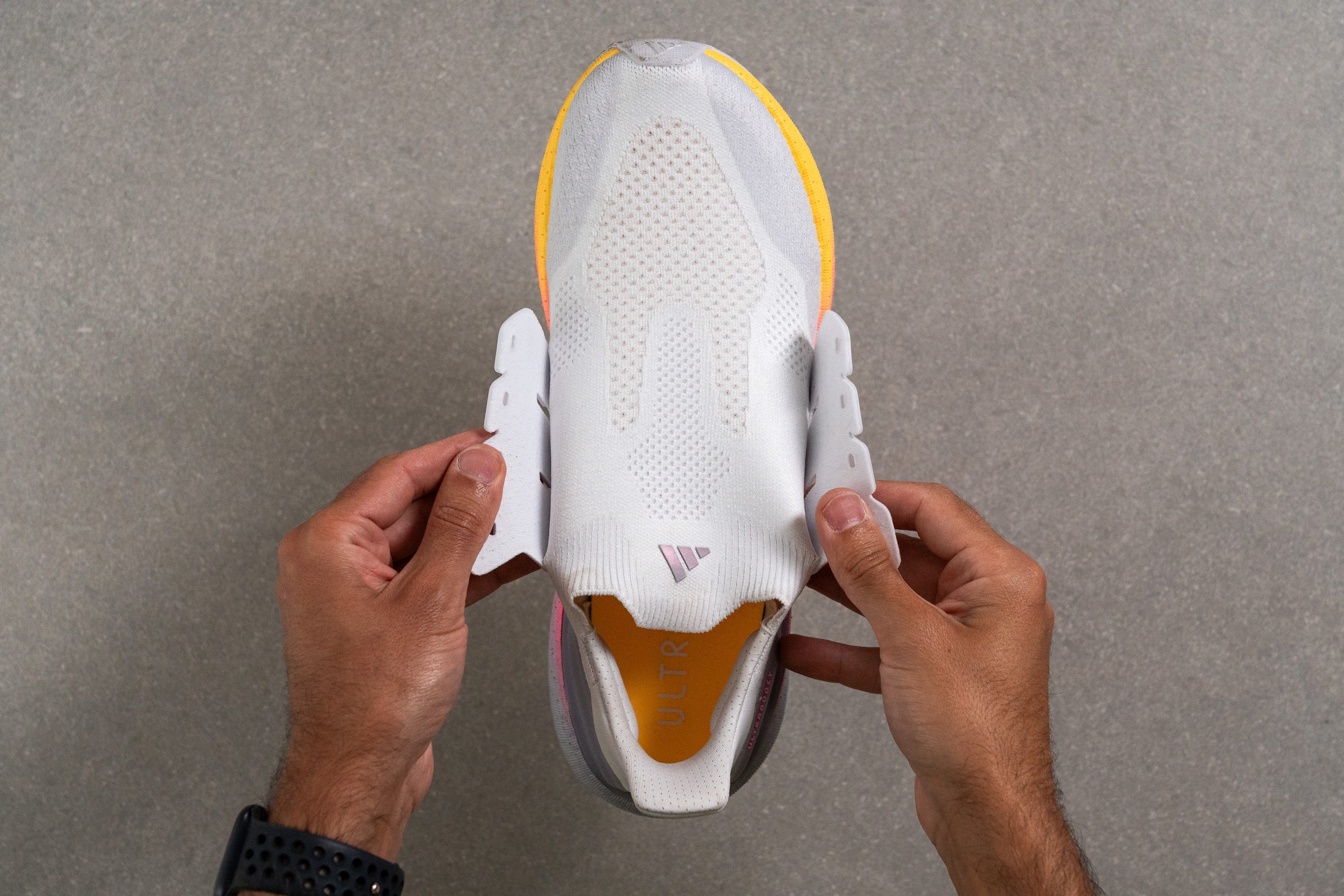
| Ultraboost 5 | Tipo calcetín |
Tirador del talón
Uno de los elementos de diseño característicos de todas las Ultraboost, y que las 5 también tienen, es ese cuello hacia arriba en la zona del talón. Hemos descubierto que esta característica no solo protege el tendón de Aquiles, sino que también hace que calzarse sea más fácil si tiras de él.
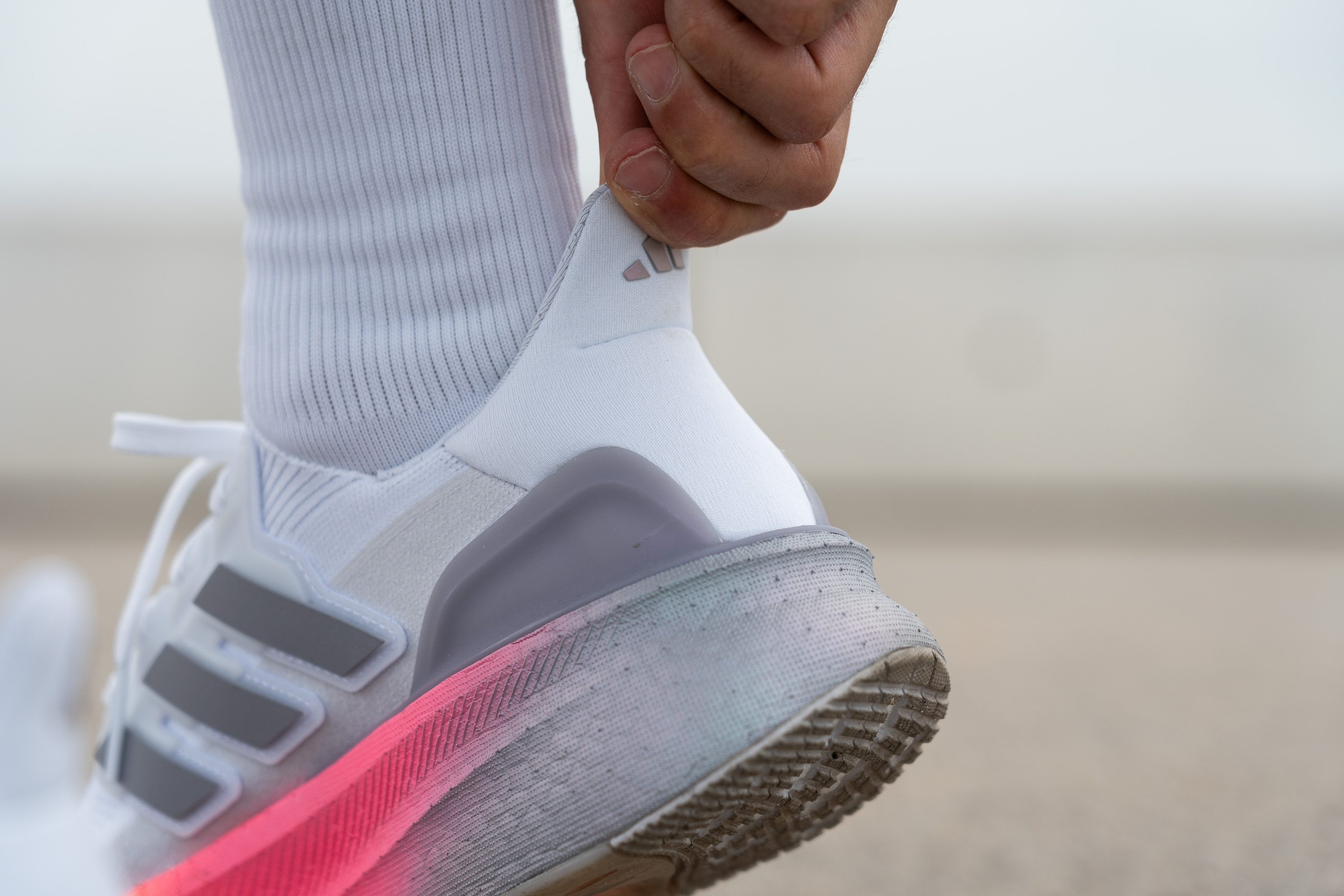
| Ultraboost 5 | Talón extendido |

